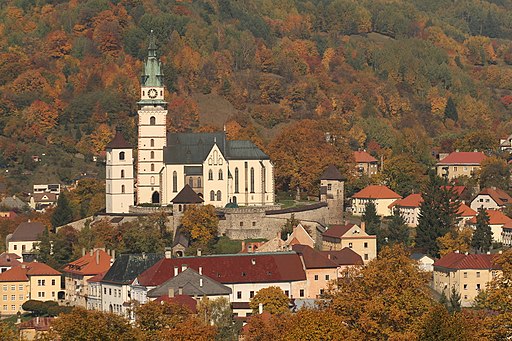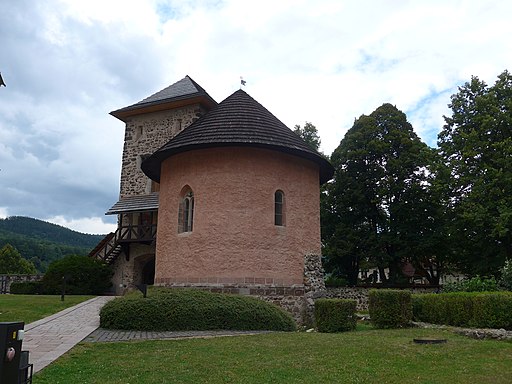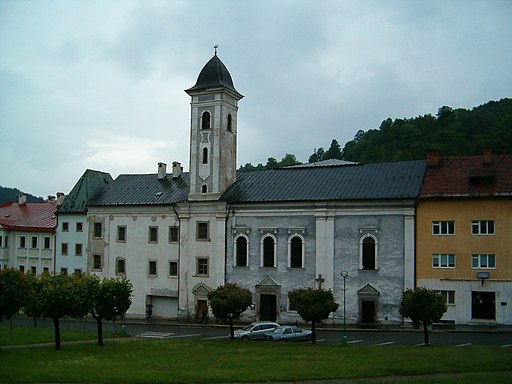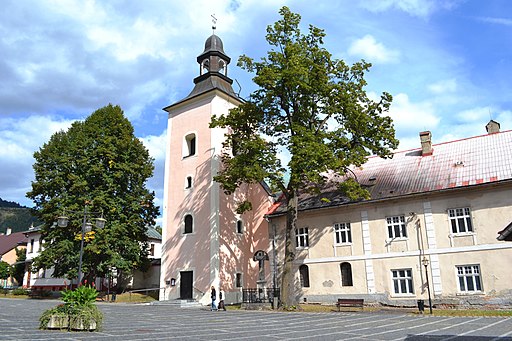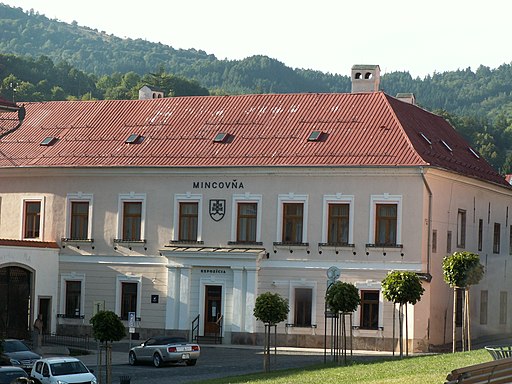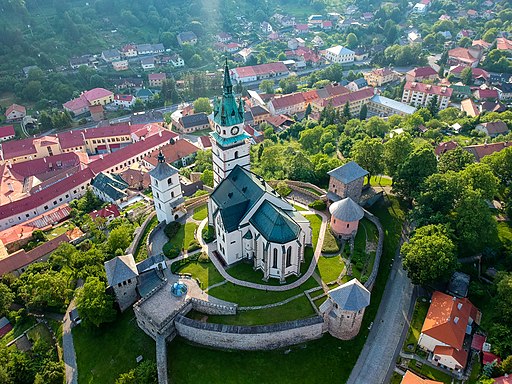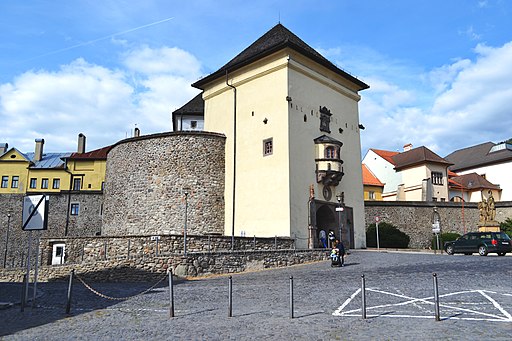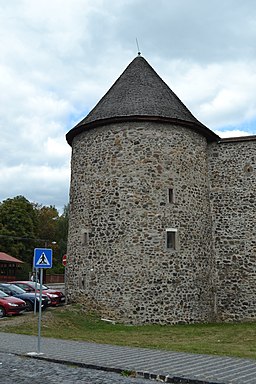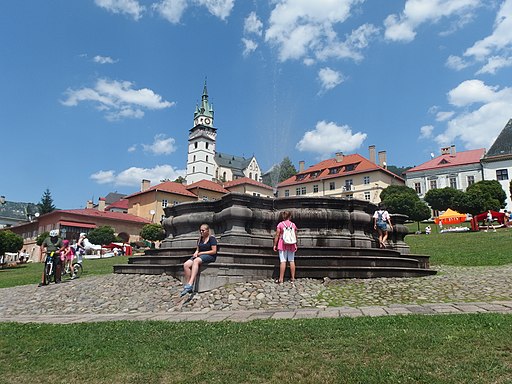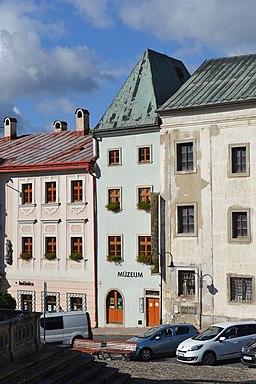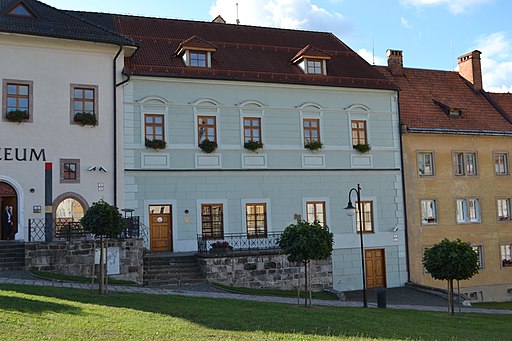Körmöcbánya
Historical Hungarian county:
Bars
District:
Banskobystrický kraj
River:
Bisztrica Brook and Körmöc Brook
GPS coordinates:
48.70471, 18.917529
Population
Population in 1910
| Total |
4515 |
| Hungarian |
33.24% |
| German |
33.53% |
| Slovak |
32.61% |
The town was one of the most important mining towns of Hungary, which was famous for its gold mines and its coin mint. It was founded by German settlers in the 12th century. Its coin mint was established by King Charles I of Hungary, who started minting gold florins in the town in 1335, which became popular all over Europe. At that time Hungary gave 80 percent of Europe's gold production. At its heyday 14,000 gold coins were minted here annually. The last gold ducats (as the coins were later called) used as money were minted in 1881. In October 1918, the minting machines had to be evacuated to Budapest from the occupying Czechs. The traditions of minting are presented to the visitors by the Coin and Medal Museum and the coin mint.
Check out other towns in Upper Hungary (Slovakia) as well!
895
Arrival of the Hungarians
Little more...
895
The alliance of the seven Hungarian tribes took possession of the then largely uninhabited Carpathian Basin. Until then, the sparse Slavic population of the north-western Carpathians had lived under Moravian rule for a few decades after the collapse of the Avar Khaganate in the early 9th century.
1000
Foundation of the Hungarian Kingdom
Little more...
1000
The Kingdom of Hungary was established with the coronation of King Stephen I. He converted the Hungarians to Christianity and created two archdioceses (Esztergom and Kalocsa) and ten dioceses. He divided Hungary into counties led by ispáns, who were appointed by the king.
12th century
The settlement was founded by settlers from Silesia and Thuringia.
1241-1242
Mongol Invasion
Little more...
1241-1242
The hordes of the Mongol Empire invaded Hungary and almost completely destroyed it. One third to one half of the population was destroyed. The Mongols also suffered heavy losses in the battle of Muhi and they could not hunt down the king. After their withdrawal, King Béla IV reorganized Hungary. He allowed the feudal lords to build stone castles because they were able to successfully resist the nomadic Mongols. The vast majority of stone castles were built after this. The king called in German, Vlach (Romanian) and Slavic settlers to replace the destroyed population.
1301
The extinction of the House of Árpád
Little more...
1301
The House of Árpád, the first Hungarian royal dynasty, died out with the death of King Andrew III. Hungary was ruled by oligarchs, the most powerful of whom was Csák Máté, whose main ally was the Aba family. King Charles I (1308-1342), supported by the Pope, eventually emerged as the most prominent of the contenders for the Hungarian throne. But it took decades to break the power of the oligarchs.
1328
King Charles I of Hungary made it a free royal town and founded its coin mint.
1329
King Charles I of Hungary started to mint silver coins (garas) in Körmöcbánya.
1335
King Charles I of Hungary started to mint the gold florins in Körmöcbánya. It was later called ducat. The king founded several Minting Chambers. The Hungarian mints, which gained their fame in the following centuries, were established at that time. There were altogether 10 mints in the country (Buda, Kolozsvár, Nagybánya, Körmöcbánya etc.).
1425
The town gained the privilege to hold weekly markets.
1432
The Czech Hussite marauders captured and pillaged the town.
1440
After the death of King Albert of the House of Habsburg, the Estates of Hungary elected the Polish Ulászló to the throne. Elisabeth, the widow queen, in order to secure the throne for László, her baby boy, called in the Czech Hussite mercenary leader Jan Jiskra. She gave him the title "Captain of the Mining Towns and Kassa", and gave him the castle of Zólyom.
1440-1441
The Czech Hussites soon occupied much of northern Hungary. They reinforced the castles and turned them into bandit lairs. They were pillaging everywhere and large areas became uninhabited. They wiped out the local German and Hungarian population, who were replaced by Czech and other Slavic settlers. The Czech Hussite devastation largely contributed to the Slavicisation of northern Hungary (now Slovakia).
1449
Hunyadi János besieged the town, but he could not take it back from the Hussites.
1462
At the end of the war that King Matthias of Hungary had waged against the Hussites since 1458, Jiskra swore loyalty to the king and handed over the castles he still held. Afterwards Jiskra fought in the service of King Matthias until his death.
14-15th century
The golden age of the town. 14,000 gold florins were minted in the town annually.
1526
Battle of Mohács and the splitting of Hungary into two parts
Little more...
1526
Sultan Suleiman I launched a war against Vienna, instigated by the French. Ferdinand I, Duke of Austria, was the brother-in-law of King Louis II of Hungary. The army of the Ottoman Empire defeated the much smaller Hungarian army at Mohács, and King Louis II died in the battle. A group of the barons elected Ferdinand I of the House of Habsburg to the throne, who promised to defend Hungary from the Turks. He was the younger brother of the most powerful European monarch Emperor Charles V. But the nobility chose the most powerful Hungarian baron, Szapolyai János, who was also crowned as King John I. The country was split in two and a decades-long struggle for power began.
1541
The Turkish occupation of the capital, Buda, and the division of Hungary into three parts
Little more...
1541
The Turks conquered Buda, the capital of Hungary, after the death of King John I. The central part of the country was under Turkish rule for 150 years. The western and northern parts (including present-day Slovakia) formed the Kingdom of Hungary ruled by the Habsburg emperors. The eastern parts (now mainly under Romanian rule) were ruled by the successors of King John I of Hungary. In 1571, John II (John Sigismund), the son of King John I of Hungary, renounced the title of King of Hungary in favor of King Maximilian of the House of Habsburg, and henceforth held the title of Prince. This formally created the Principality of Transylvania, which was the eastern half of Hungary not ruled by the Habsburgs and was also a vassal of the Ottoman Empire. John II died in 1571, after which the three nations of Transylvania (the Hungarian nobility, the Székelys and the Saxons) elected the prince.
1604-1606
Uprising of Bocskai István
Little more...
1604-1606
The alliance of the Habsburgs and the Principality of Transylvania was defeated by the Ottoman Empire in the Fifteen Years' War. The war devastated Transylvania, which was occupied by the Habsburg imperial army, and General Basta introduced a reign of terror. The nobility and the burghers were upset about the terror, the plundering mercenaries and the violent Counter-Reformation. Bocskai István decided to lead their uprising after the Habsburg emperor tried to confiscate his estates. Bocskai also rallied the hajdú warriors to his side. He was elected Prince of Transylvania and soon liberated the Kingdom of Hungary from the Habsburgs. In 1605 Bocskai István was crowned King of Hungary with the crown he received from the Turks.
1605
The town surrendered to Bocskai István.
23 June 1606
Peace of Vienna
Little more...
23 June 1606
Bocski István made peace with Emperor Rudolf. Their agreement secured the constitutional rights of the Estates of Hungary, and the freedom of religion. The counties of Szatmár, Bereg and Ugocsa were annexed to the Principality of Transylvania. Bocskai died of illness in the same year, leaving to his successors the idea of unifying Hungary from Transylvania.
1619
The campaign of Prince Bethlen Gábor of Transylvania in the Thirty Years' War
Little more...
1619
At the beginning of the Thirty Years' War (1618-1648), Prince Bethlen Gábor of Transylvania went to war against the Habsburg emperor as an ally of the rebelling Czech-Moravian-Austrian estates. The whole Kingdom of Hungary joined him, only the Austrian defenders of Pozsony had to be put to the sword. With his allies, he laid siege to Vienna. However, he was forced to abandon the siege because the Habsburg-loyal Hungarian aristocrat Homonnai Drugeth György attacked his heartland with Polish mercenaries. On 25 August 1620, the Diet of Besztercebánya elected Bethlen Gábor King of Hungary as vassal of the Turks. He continued to fight after the defeat of the Czechs at White Mountain on 8 November 1620, but without real chance to achieve decisive victory, he decided to come to an agreement with Emperor Ferdinand II.
September 1619
Prince Bethlen Gábor of Transylvania occupied the town peacefully.
early June, 1621
Körmöcbánya surrendered to the Imperials.
July 5, 1621
After the victory of Egry István at Zólyom, the town surrendered to Prince Bethlen Gábor of Transylvania again.
31 December 1621
Peace of Nikolsburg
Little more...
31 December 1621
Prince Bethlen Gábor of Transylvania made peace with Emperor Ferdinand II. Their agreement secured the constitutional rights of the Estates of Hungary, and later it was supplemented with the freedom of religion. Bethlen renounced the title of King of Hungary in exchange for seven counties of the Upper Tisza region (Szabolcs, Szatmár, Bereg, Ugocsa, Zemplén, Borsod, Abaúj) for the rest of his life, other estates in Hungary as his private property and the imperial title of Duke of Oppeln and Ratibor (Opole and Racibórz), one of the Duchies of Silesia. Prince Bethlen went to war against the Habsburgs in 1623 and 1626, but was unable to negotiate more favourable terms.
1644-1645
The campaign of Prince Rákóczi György I of Transylvania in the Thirty Years' War
Little more...
1644-1645
Prince Rákóczi György I of Transylvania allied with the Swedes and the French in the Thirty Years' War and went to war against the Habsburg Emperor Ferdinand III. On 18 July 1645 his army joined forces with Torstenson's Swedish army under Brno (Moravia). The excellent artillery of Transylvania opened fire on the city walls. However, Rákóczi had to give up the siege, having been informed that the Turks were planning a punitive campaign against Transylvania, because he went to war against the Sultan's prohibition.
early April, 1644
The mining towns surrendered to Prince Rákóczi György I of Transylvania for a short time.
16 December 1645
Peace of Linz
Little more...
16 December 1645
Prince Rákóczi György I of Transylvania made peace with Emperor Ferdinand III. It secured the freedom of religion for the Protestants and extended it also to the serfs. Rákóczi received the same seven Hungarian counties that Prince Bethlen Gábor had also held (Abauj, Zemplén, Borsod, Bereg, Ugocsa, Szabolcs, Szatmár) until his death, and the counties of Szabolcs and Szatmár were also to be inherited by his sons. The Rákóczi family also received several new estates.
1652
A paper mill was established.
after 1671
Kuruc Movement
Little more...
after 1671
Many noble, burgher and preacher fled to the Principality of Transylvania and the territory under Turkish occupation from the reprisals after the exposure of the anti-Habsburg Wesselényi-conspiracy and from the violent Counter-Reformation. They were joined by dismissed Hungarian soldiers of the Turkish border forts, who were replaced by German mercenaries. They were called the fugitives (bujdosók). They started an armed movement against the Habsburg rule. Because of the Turkish ban, the Principality of Transylvania could not openly support them. From 1677, the French supported their cause with money and Polish mercenaries. They achieved their first serious success when they temporarily occupied the mining towns of northern Hungary (now central Slovakia) under the command of Thököly lmre. He then became the sole leader of the movement. In 1679, the French made peace with Emperor Leopold I and withdrew their support for the fugitives. Between 1678 and 1681 Thököly Imre led successful raids against the Habsburgs and their supporters in the territory of the Kingdom of Hungary. The insurgents were called kurucs.
October 1678
The town surrendered to the kuruc army of Thököly Imre after the first attack, but they had to empty the town after the defeat at Barsszentkereszt on 1st of November.
1682
Thököly Imre, Prince of Upper Hungary
Little more...
1682
Thököly Imre, the leader of the kuruc insurgents, gained the support of the Turks. He launched a campaign against the Habsburgs in the Kingdom of Hungary. With the support of the Turkish army, he occupied the town of Kassa and also the important stronghold of Fülek. He was then recognized by the Turks as King of Hungary, but he chose the title of Prince of Upper Hungary.
September 1682
After the united armies of Thököly Imre kuruc leader and the Turks captured Fülek, the Imperial army of Caprara, consisting of mainly fresh recruits, retreated to Trencsén. Thököly occupied Zólyom and sent Görgey Boldizsár to capture the mining towns. They returned with rich booty.
November 19, 1682
Thököly Imre signed a truce with the Imperials. The kuruc rule extended to the Garam River, but the mining towns were given back to the Emperor in exchange for a monthly tribute of 3,000 gold florins.
July 1, 1683
The Imperial commander Schulz received orders to empty the mining towns and retreat to the defense of Vienna, because a huge Turkish army was on the way to take it.
1683
Turkish defeat at Vienna and the formation of the Holy League
Little more...
1683
The combined armies of the Habsburg Empire and the Kingdom of Poland defeated the Turkish army besieging Vienna. Emperor Leopold I wanted to make peace with the Turks, but was refused by Sultan Mehmed IV. In 1684, at the persistent urging of Pope Innocent XI, the Holy League, an alliance of the Kingdom of Poland, the Habsburg Empire, the Republic of Venice and the Papal States, was formed to expel the Turks from Hungary. Thököly Imre, who had allied himself with the Turks, was gradually driven out of northern Hungary.
autumn 1683
After the Turkish defeat at Vienna, the town was again under Habsburg rule.
1685
The Turkish captivity of Thököly Imre and the fall of the kuruc movement
Little more...
1685
The Pasha of Várad captured Thököly Imre as he was asking for Turkish help and offered him to Emperor Leopold I for peace. But the Imperial emissaries laughed at his face, because, having the upper hand, they no longer cared for Thököly. On the news of his capture, the town of Kassa and the kuruc strongholds surrendered to the Emperor one after the other. The Turks, seeing their fatal mistake, released Thököly the following year and tried to restore his authority, but his power was broken forever and the Hungarian insurgents no longer trusted the Turks. Most of the insurgents joined the imperial army and helped to liberate the rest of Hungary from the Turks.
1686
Recapture of Buda and the liberation of Hungary from the Turks
Little more...
1686
The army of the Holy League recaptured Buda from the Turks by siege. In 1687, the Imperial army invaded the Principality of Transylvania. The liberation was hindered by the French breaking their promise of peace in 1688 and attacking the Habsburg Empire. By 1699, when the Peace of Karlóca was signed, all of Hungary and Croatia had been liberated from the Ottoman Empire with the exception of Temesköz, the area bounded by the Maros, the Tisza and the Danube rivers. It was not until the Peace of Požarevac in 1718 that Temesköz was liberated from the Turks. However, the continuous war against the Turkish invaders and the Habsburg autocracy, which lasted for more than 150 years, wiped out large areas of the Hungarian population, which had previously made up 80% of the country's population, and was replaced by Vlachs (Romanians), Serbs and other Slavic settlers and Germans. The Habsburgs also favoured the settlement of these foreign peoples over the 'rebellious' Hungarians.
1696
The town was granted the right to hold country fairs.
1703-1711
Hungarian War of Independence led by Prince Rákóczi Ferenc II
Little more...
1703-1711
After the expulsion of the Turks, the Habsburgs treated Hungary as a newly conquered province and did not respect its constitution. The serfs rose up against the Habsburg ruler because of the sufferings caused by the war and the heavy burdens, and they invited Rákóczi Ferenc II to lead them. Trusting in the help promised by King Louis XIV of France, he accepted. Rákóczi rallied the nobility to his side, and soon most of the country was under his control. The rebels were called the kurucs. In 1704, the French and the Bavarians were defeated at the Battle of Blenheim, depriving the Hungarians of their international allies. The Rusyn, Slovak and Vlach peasants and the Saxons of Szepes supported the fight for freedom, while the Serbs in the south and the Saxons in Transylvania served the Habsburgs. Due to lack of funds Rákóczi could not raise a strong regular army, and in 1710, Hungary was also hit by a severe plague. Rákóczi tried unsuccessfully to forge an alliance with Tsar Peter the Great of Russia. In his absence, without his knowledge, his commander-in-chief, Károlyi Sándor, accepted Emperor Joseph I's peace offer. The Peace of Szatmár formally restored the Hungarian constitution and religious freedom and granted amnesty, but did not ease the burden of serfdom. Rákóczi refused to accept the pardon and went into exile. He died in Rodosto, Turkey.
1703
The kuruc army occupied the town. The mint of Körmöcbánya was the main funder of Rákóczi's war of independence.
October 25, 1708
After the lost battle at Trencsén, the Imperials occupied the town.
1848-1849
Hungarian Revolution and War of Independence
Little more...
1848-1849
Following the news of the Paris Revolution on 22 February 1848, the Hungarian liberal opposition led by Kossuth Lajos demanded the abolition of serfdom, the abolition of the tax exemption of the nobility, a parliament elected by the people, and an independent and accountable national government. The revolution that broke out in Pest on 15 March expressed its demands in 12 points, which, in addition to the above mentioned, included the freedom of the press, equality before the law, the release of the political prisoners and the union with Transylvania. A Hungarian government was formed, Batthyány Lajos became prime minister, and on 11 April Emperor Ferdinand V ratified the reform laws. On August 31 the Emperor demanded the repeal of the laws threatening with military intervention. In September the Emperor unleashed the army of Jelacic, Ban of Croatia, on Hungary, but they were defeated by the Hungarians in the Battle of Pákozd on 29 September. An open war began for the independence of Hungary. The Habsburgs incited the nationalities against the Hungarians. The Rusyns, the Slovenes and most of the Slovaks and Germans supported the cause persistently, but the Vlachs (Romanians) and the Serbians turned against the Hungarians. The glorious Spring Campaign in 1849 led by General Görgei Artúr liberated almost all of Hungary. On 1 May 1849, Emperor Franz Joseph, effectively admitting defeat, asked for the help of Tsar Nicholas I of Russia, who sent an intervention army of 200,000 soldiers against Hungary. The resistance became hopeless against the overwhelming enemy forces and on 13 August Görgei Artúr surrendered to the Russians at Világos. Bloody reprisals followed, and on 6 October 1849, 12 generals and a colonel of the Hungarian Revolution, the martyrs of Arad, were executed in Arad. On the same day, Batthyány Lajos, the first Hungarian Prime Minister, was executed by firing squad in Pest. The Habsburgs introduced total authoritarianism in Hungary, but they also failed to fulfil their promises to the nationalities that had betrayed the Hungarians.
1849
The Hungarian general Görgey Artúr clashed with the Imperials in Körmöcbánya during the winter campaign and he managed to break out towards Besztercebánya through a mining tunnel.
1867
Austro-Hungarian Compromise
Little more...
1867
The Habsburg Empire was weakened by the defeats it suffered in the implementation of Italian and German unity. The Hungarians wanted to return to the reform laws of 1848, but they did not have the strength to do so. Emperor Franz Joseph and the Hungarian opposition, led by Deák Ferenc, finally agreed to restructure the Empire and abolish absolutism. Hungary was given autonomy in its internal affairs, with its own government and parliament, which was essential for the development of its economy and culture. However, foreign and military affairs remained in the hands of the Habsburgs and served their aspiration for becoming a great power. The majority wanted Hungary's independence, but they were excluded from political power.
1869-1872
The railway reached the town.
1881
The last gold dukats used as money were minted.
1914-1918
World War I
Little more...
1914-1918
As part of the Austro-Hungarian Monarchy, Hungary took part in the war on the side of the Central Powers.
November 1918 - January 1919
The Czech, Romanian and Serbian occupation of Hungary
Little more...
November 1918 - January 1919
In Hungary, the freemasonic subversion brought the pro-Entente Károlyi Mihály to power. The new government, naively trusting the Entente powers, met all their demands and disbanded the Hungarian military, which rendered the country completely defenseless in the most dire need. Under French and Italian command, Czech, Romanian and Serbian troops invaded large parts of Hungary, where they immediately began the takeover. They fired Hungarian railway workers, officials and teachers, banned the use of the Hungarian language, abolished Hungarian education, and disposed of everything that reminded them of the country's Hungarian past. Hundreds of thousands of Hungarians were forced to leave their homeland, and the forcible assimilation of the remaining Hungarians was begun.
October 25-30, 1918
The minting machines and the noble metal were transported to Budapest to save them from the Czechoslovak invaders.
December 15, 1918
The Czechoslovaks invaded Körmöcbánya.
4 June 1920
Trianon Dictate
Little more...
4 June 1920
Hungary was forced to sign the Treaty of Trianon, although the country was not invited to the peace talks. Hungary lost two thirds of its territory that had belonged to it for more than 1000 years. One-third of the Hungarian population came under foreign rule. On the basis of the national principle, countries with a more mixed and less ethnically balanced composition than the former Hungary were created, such as Czechoslovakia and the Kingdom of Serbs, Croats and Slovenes (later Yugoslavia). For example, while 48% of the population of the territory ceded to Czechoslovakia was Slovak and 30% Hungarian, 54% of the population of the former Hungary was Hungarian and 10.6% Slovak. And in the territory that is now part of Serbia, the Hungarians outnumbered the Serbs. The part of the territory allocated to Romania from Hungary was larger than the remaining territory of Hungary, despite the fact that there were 10 million Hungarians and less than 3 million Romanians in the former Hungary. While Hungary used to have the most liberal nationality policy in Europe, the successor states had no respect at all for the national and cultural rights of the indigenous Hungarians and engaged in forced assimilation. The Trianon Dictate destroyed the organic economic unity of the region. Before the First World War, Hungary had a dynamic economy, more advanced than Spain's. After 1920, the successor states formed the so-called "Little Entente", putting Hungary under an economic blockade and sabotaging it on the international stage.
14 March 1939
First independent Slovakia was established
Little more...
14 March 1939
The first independent Slovakia was established under German patronage. Josef Tiso became president of the country. In 1938, Hungary regained 11,927 km2 of territory from Czechoslovakia under the First Vienna Award. Its population was 869 thousand people, 86.5% of whom were Hungarian. From the remaining territory that Hungary did not get back, Slovakia was formed.
Autumn 1944 - Spring 1945
Soviet occupation
Little more...
Autumn 1944 - Spring 1945
The Soviet Red Army occupied Hungary and Slovakia, which resulted in the recreation of Czechoslovakia.
5 April 1945
Beneš decrees and the persecution of Hungarians
Little more...
5 April 1945
In Hungarian-majority Kassa, the president of occupying Czechoslovakia, Edvard Beneš, promulgated his government program, the so-called Beneš decrees. As part of this, the Hungarian population was deprived of their rights. Their complete expulsion was planned, with the support of the Soviet Union, and only the veto of the USA prevented it. Under the 'Reslavakization' programme, only those Hungarians who recognised themselves as Slovaks were allowed to regain their rights, thus renouncing all linguistic and cultural rights. In the violent expulsions that followed, nearly 200,000 Hungarians were deprived of their property and expelled from their homeland on the basis of their nationality.
1 January 1993
Dissolution of Czechoslovakia
Little more...
1 January 1993
Czechoslovakia disintegrated due to ethnic differences between Czechs and Slovaks, shortly after the withdrawal of Soviet tanks. Slovakia was formed entirely from territory carved out of historic Hungary, and Slovak national identity is still largely based on falsified history and artificial hatred of Hungarians. Despite deportations, expulsions, forced assimilation and strong economic pressure, there are still nearly half a million Hungarians living in the country.
Sights
All
Churches, religious buildings
Public buildings
Cultural facilities
Commerce, industry, hospitality
Town infrastructure
Private buildings
Memorials
Museums and Galleries
Churches, religious buildings
St. Catherine Roman Catholic Church
Kostol svätej Kataríny
Show on map
Visit
St. Catherine Roman Catholic Church
History
The church was built between 1465 and 1485 in Gothic style on the former Romanesque church. Its tower gained its Renaissance appearance by 1579 after the fire in 1560. The church was reconstructed in neo-Gothic style between 1883 and 1886 led by the architect Storno Ferenc. The tower serves as a lookout and can be visited by tourists.
The statue of Virgin Mary on the side altar is from the 15th or 16th century. The neo-Gothic main altar was made in the 19th century and there is a statue of Virgin Mary on it from the 15th or 16th century.
Round Church of St. Andrew the Apostle
Kaplnka sv. Ondreja a Karner
Show on map
Visit
Round Church of St. Andrew the Apostle
History
The church is in one of the round bastions of the castle, it is the oldest part of the castle. It was built in the 13th century and it was the original church of the castle dedicated to St. Michael. It is a two-story structure. There is an ossuary in the basement and a chapel on the ground floor. The chapel was built in the 14th century in Romanesque style and it has Gothic frescos. The ossuary served as an armory for some time. The small church was consecrated again in 1731, but only as a chapel dedicated to St. Andrew.
Franciscan Church and Monastery
Kláštor sv. Františkaz Assisi
Originally:
church and monastery
Currently:
church and monastery
Show on map
Visit
Franciscan Church and Monastery
History
The Franciscans settled down in Körmöcbánya in 1649. They were invited by Archbishop Lippay György of Esztergom. The construction of the church was started in 1653 and was dedicated to St. Francis of Assisi. After the demolition of the parish church, the side altars, the baptistery and the picture of the main altar depicting the Assumption of Virgin Mary into Heaven were moved to the Franciscan church. The altar picture is now in the National Gallery of Pozsony. The church was only consecrated in 1715. The Chapel of Loretto was built in 1758.
The eastern wing of the monastery was built in 1653 at the initiative of Archbishop Lippay György of Esztergom. The monastery was expanded to the west in 1702. The so called Franciscan bastion was incorporated into the western wing. The monks lived in the monastery for 300 years, but in 1949 during the Communism they were deported to labor camps.
St. Elisabeth of Hungary Hospital Church
Kostol svätej Alžbety vdovy
Show on map
Visit
St. Elisabeth of Hungary Hospital Church
History
The church was built in Gothic style between 1382 and 1393 next to the hospital with the contribution of King Louis I of Hungary. It was originally dedicated to the Holy Cross.
On the keystone of the arch above the organ a mining symbol is carved: a hoe and a pickaxe crossed before a shield, and there is a cross above it. This proves that the church was attended by the families of miners. On the keystone of the central arch, the coat of arms of Hungary can be seen with ten lilies. On the keystone of the front arch the coat of arms of the House of Anjou can be seen with two lilies, as King Louis I was of the House of Anjou.
The church burned down in 1707, and afterwards the tower was rebuilt from stone. The entire interior of the church was renovated in five years. On the ground floor of the bell tower a main entrance was made for the church. After the reconstruction the church was dedicated to St. Elisabeth of Hungary in 1712. The church got new furnishings between 1902 and 1906.
Lutheran Church
Evanjelický kostol
Show on map
Visit
Lutheran Church
History
The church was built between 1824 and 1826 in Classicist style on the site of the former wooden church built in 1688.
Calvary, Church of the Holy Cross
Kremnická Kalvária
Show on map
Visit
Calvary, Church of the Holy Cross
History
The Calvary was built between 1729 and 1734 and was dedicated to the finding of the True Cross. A procession is arranged every year from the main parish church of Virgin Mary to the Calvary to gain full indulgence.
Roman Catholic Parish
Show on map
Visit
Roman Catholic Parish
History
The building was created in the second half of the 18th century by joining two houses from the end of the 14th century. It became the building of the parish at that time. It has a facade of Zopf-Empire style.
Public buildings
Old Town Hall in the Castle
Radnica
Show on map
Visit
Old Town Hall in the Castle
History
The old town hall was built in the 14th century and was incorporated into the castle wall. It was renovated at the beginning of the 15th century and also at the end of the 16th century, the second time in Renaissance style. After the fire in 1560 the town council moved to the lower castle. The building was damaged in the earthquake in 1879 and the two topmost floors were demolished in 1887 during the reconstruction. There is an exhibition of Baroque sculptures from the churches of the town in the building.
Town Hall
Mestský úrad Kremnica
Show on map
Visit
Town Hall
History
The house was mentioned for the first time in 1441. The Gothic burgher's house was turned into town hall after the town purchased it in 1738. The upstairs great hall is decorated by the paintings of Angyal Géza.
Cultural facilities
former Grammar School
Základná škola Pavla Križku
Show on map
Visit
former Grammar School
History
The building of the former grammar school was built in 1885.
Commerce, industry, hospitality
Coin Mint
Mincovňa Kremnica
Show on map
Visit
Coin Mint
History
Körmöcbánya was granted town status by King Charles I of Hungary, because it became the seat of the largest Minting and Mining Chamber of Hungary. They started to mint silver coins in 1329 and gold florins in 1335. The gold coins were later called ducats. The mines produced around 400 kilograms of gold annually in the 14th century. In the 16th century royal power in Hungary weakened and the Thurzó and Fugger families took over the operation of the mines of Körmöcbánya.
The coin mint was moved to the building within the town walls that still functions as a medal mint in the 15th century. Coins were minted in the building until 1986. The building gained its current form between 1881 and 1889, when it was reconstructed in neo-Renaissance style.
Town infrastructure
Castle
Mestsky Hrad
Originally:
castle / fortification
Show on map
Visit
Castle
History
The castle was built in the 14th and 15th centuries with double walls.
Southern Tower of the Castle
Južná veža
Originally:
castle / fortification
Show on map
Visit
Southern Tower of the Castle
History
The tower was built in the second half of the 14th century and the parish office occupied it until the 15th century. The stairway that connects the castle with the town was built after 1780. At the end of the 19th century bells were placed on the 1st floor. At present visitors can access the castle through the southern tower, which has also a treasury.
Miner's Bastion
Banícka bašta
Originally:
castle / fortification
Show on map
Visit
Miner's Bastion
History
The bastion was originally the presbytery of the never-finished church of the Nativity of Virgin Mary. It was built around 1450 and was turned into a bastion in the 16th century.
Clock Tower and Bastion Gate
Malá veža
Originally:
castle / fortification
Show on map
Visit
Clock Tower and Bastion Gate
History
It was built in the 14th century and it was the gate tower of the bastion as well. At the end of the 17th century another floor was added for the bells. The oldest bell of the town, the Urban bell from 1588, can be found in the tower. A clock was installed on the second floor in the 18th century but it was relocated to the church tower in the next century.
There is an exhibition of bells and bell-making in the tower.
Northern Tower of the Castle
Severná veža
Originally:
castle / fortification
Show on map
Visit
Northern Tower of the Castle
History
It is a four-story structure from the second half of the 14th century. The top floor and the passage in front of the 1st floor were built after the fire in 1560. The tower protected the drawbridge of the entrance, which was replaced by a stone bridge in 1886.
It has an exhibition of archeology relating to the castle and it also presents how the town was defended in the medieval times.
Lower Gate
Show on map
Visit
Lower Gate
History
A barbican was built in 1539 to the southern gatehouse of the town. On the northern facade of the tower of the barbican two round reliefs illustrate King Ferdinand I of Hungary and his wife, Queen Anne.
Black Tower of the Town Walls
Čierna veža
Originally:
town fortification
Currently:
town fortification
Show on map
Visit
Black Tower of the Town Walls
History
It is part of the town walls.
Red Tower of the Town Walls
Červená veža
Originally:
town fortification
Currently:
town fortification
Show on map
Visit
Red Tower of the Town Walls
History
It was once a prison, a torture chamber and the house of the executioner. It is part of the town walls.
Baroque Fountain
Baroková fontána
Show on map
Visit
Baroque Fountain
History
The fountain was made in the 18th century possibly by Dionysius Ignatius Stanetti. Originally the statue of Neptun stood in the middle.
Private buildings
Coin and Medal Museum of Körmöcbánya
Múzeum mincí a medailí
Originally:
house, parish, town hall
Show on map
Visit
Coin and Medal Museum of Körmöcbánya
History
The numismatic-historical exhibition of the Museum of Körmöcbánya is located in a medieval Gothic burgher's house from the 14th century. The house was the parish building of the demolished church of Virgin Mary until 1652. Afterwards it served as town hall until 1738. It was turned into a residential house at the end of the 18th century. The statue of St. Florian is standing on its courtyard. Behind the house a late Baroque residential building stands on the site of the former White Tower.
Exhibition Hall of the Museum of Körmöcbánya
Mestiansky Dom
Show on map
Visit
Exhibition Hall of the Museum of Körmöcbánya
History
Temporary exhibitions are organized in the building from the collection of the museum.
Coin and Medal Museum of Körmöcbánya
Show on map
Visit
Coin and Medal Museum of Körmöcbánya
History
It is a Gothic burgher's house from the 14th century, which was reconstructed in 1568. The numismatic exhibition of the Museum of Körmöcbánya is located in the building.
former House of Queen Mary
Show on map
Visit
former House of Queen Mary
History
The house was once owned by Queen Mary, the wife of King Louis II of Hungary (1516-1526).
Miners' Houses
Show on map
Visit
Miners' Houses
History
The former houses of the miners were built in the 19th century and at the beginning of the 20th century.
Gallery
Show on map
Visit
Gallery
History
The temporary exhibitions of the Museum of Körmöcbánya are held in the gallery.
Memorials
Trinity Statue
Morový stĺp svätej Trojice
Originally:
statue / memorial / relief
Currently:
statue / memorial / relief
Show on map
Visit
Trinity Statue
History
The statue was made between 1765 and 1772 by the sculptors Dionysius Ignatius Stanetti and M. Vogerle in memory of the plague.
Immaculata Statue
Originally:
statue / memorial / relief
Currently:
statue / memorial / relief
Show on map
Visit
Immaculata Statue
History
The statue stands between the Miner's Bastion and the Chapel of St. Andrew. It is the copy of the statue of Dionysius Ignatius Stanetti made between 1760 and 1765. The original statue stands under the organ loft of St. Catherine's Church.
Museums and Galleries
Castle
Mestsky Hrad
Originally:
castle / fortification
Show on map
Visit
Castle
History
The castle was built in the 14th and 15th centuries with double walls.
Coin and Medal Museum of Körmöcbánya
Múzeum mincí a medailí
Originally:
house, parish, town hall
Show on map
Visit
Coin and Medal Museum of Körmöcbánya
History
The numismatic-historical exhibition of the Museum of Körmöcbánya is located in a medieval Gothic burgher's house from the 14th century. The house was the parish building of the demolished church of Virgin Mary until 1652. Afterwards it served as town hall until 1738. It was turned into a residential house at the end of the 18th century. The statue of St. Florian is standing on its courtyard. Behind the house a late Baroque residential building stands on the site of the former White Tower.
Old Town Hall in the Castle
Radnica
Show on map
Visit
Old Town Hall in the Castle
History
The old town hall was built in the 14th century and was incorporated into the castle wall. It was renovated at the beginning of the 15th century and also at the end of the 16th century, the second time in Renaissance style. After the fire in 1560 the town council moved to the lower castle. The building was damaged in the earthquake in 1879 and the two topmost floors were demolished in 1887 during the reconstruction. There is an exhibition of Baroque sculptures from the churches of the town in the building.
Southern Tower of the Castle
Južná veža
Originally:
castle / fortification
Show on map
Visit
Southern Tower of the Castle
History
The tower was built in the second half of the 14th century and the parish office occupied it until the 15th century. The stairway that connects the castle with the town was built after 1780. At the end of the 19th century bells were placed on the 1st floor. At present visitors can access the castle through the southern tower, which has also a treasury.
Miner's Bastion
Banícka bašta
Originally:
castle / fortification
Show on map
Visit
Miner's Bastion
History
The bastion was originally the presbytery of the never-finished church of the Nativity of Virgin Mary. It was built around 1450 and was turned into a bastion in the 16th century.
Clock Tower and Bastion Gate
Malá veža
Originally:
castle / fortification
Show on map
Visit
Clock Tower and Bastion Gate
History
It was built in the 14th century and it was the gate tower of the bastion as well. At the end of the 17th century another floor was added for the bells. The oldest bell of the town, the Urban bell from 1588, can be found in the tower. A clock was installed on the second floor in the 18th century but it was relocated to the church tower in the next century.
There is an exhibition of bells and bell-making in the tower.
Northern Tower of the Castle
Severná veža
Originally:
castle / fortification
Show on map
Visit
Northern Tower of the Castle
History
It is a four-story structure from the second half of the 14th century. The top floor and the passage in front of the 1st floor were built after the fire in 1560. The tower protected the drawbridge of the entrance, which was replaced by a stone bridge in 1886.
It has an exhibition of archeology relating to the castle and it also presents how the town was defended in the medieval times.
Exhibition Hall of the Museum of Körmöcbánya
Mestiansky Dom
Show on map
Visit
Exhibition Hall of the Museum of Körmöcbánya
History
Temporary exhibitions are organized in the building from the collection of the museum.
Coin and Medal Museum of Körmöcbánya
Show on map
Visit
Coin and Medal Museum of Körmöcbánya
History
It is a Gothic burgher's house from the 14th century, which was reconstructed in 1568. The numismatic exhibition of the Museum of Körmöcbánya is located in the building.
Gallery
Show on map
Visit
Gallery
History
The temporary exhibitions of the Museum of Körmöcbánya are held in the gallery.
Coin Mint
Mincovňa Kremnica
Show on map
Visit
Coin Mint
History
Körmöcbánya was granted town status by King Charles I of Hungary, because it became the seat of the largest Minting and Mining Chamber of Hungary. They started to mint silver coins in 1329 and gold florins in 1335. The gold coins were later called ducats. The mines produced around 400 kilograms of gold annually in the 14th century. In the 16th century royal power in Hungary weakened and the Thurzó and Fugger families took over the operation of the mines of Körmöcbánya.
The coin mint was moved to the building within the town walls that still functions as a medal mint in the 15th century. Coins were minted in the building until 1986. The building gained its current form between 1881 and 1889, when it was reconstructed in neo-Renaissance style.
{"item":"town","set":{"mapcenter":{"lat":"48.7047100000","long":"18.9175290000"},"townlink":"kormocbanya-kremnica","town":{"townId":34,"active":1,"name_HU":"K\u00f6rm\u00f6cb\u00e1nya","name_LO":"Kremnica","name_GE":"Kremnitz","name_LT":"Cremnicium","seolink":"kormocbanya-kremnica","listorder":11,"oldcounty":4,"country":2,"division":6,"altitude":"564","gps_lat":"48.7047100000","gps_long":"18.9175290000","population":5,"hungarian_2011":0,"population_1910":4515,"hungarian_1910":33.24,"german_1910":33.53,"slovak_1910":32.61,"romanian_1910":0,"rusin_1910":0,"serbian_1910":0,"croatian_1910":0,"slovenian_1910":0,"coatofarms":"","coatofarms_ref":"","picture":"\u003Ca title=\u0022Peko \/ CC BY-SA (https:\/\/creativecommons.org\/licenses\/by-sa\/3.0)\u0022 href=\u0022https:\/\/commons.wikimedia.org\/wiki\/File:Kremnica,_namestie.JPG\u0022\u003E\u003Cimg width=\u0022512\u0022 alt=\u0022Kremnica, namestie\u0022 src=\u0022https:\/\/upload.wikimedia.org\/wikipedia\/commons\/thumb\/0\/0c\/Kremnica%2C_namestie.JPG\/512px-Kremnica%2C_namestie.JPG\u0022\u003E\u003C\/a\u003E","picture_ref":"\u003Ca href=\u0022https:\/\/commons.wikimedia.org\/wiki\/File:Kremnica,_namestie.JPG\u0022 title=\u0022via Wikimedia Commons\u0022\u003EPeko\u003C\/a\u003E \/ \u003Ca href=\u0022https:\/\/creativecommons.org\/licenses\/by-sa\/3.0\u0022\u003ECC BY-SA\u003C\/a\u003E","georegion":"K\u00f6rm\u00f6c Mountains","river":"Bisztrica Brook and K\u00f6rm\u00f6c Brook","description":" The town was one of the most important mining towns of Hungary, which was famous for its gold mines and its coin mint. It was founded by German settlers in the 12th century. Its coin mint was established by King Charles I of Hungary, who started minting gold florins in the town in 1335, which became popular all over Europe. At that time Hungary gave 80 percent of Europe's gold production. At its heyday 14,000 gold coins were minted here annually. The last gold ducats (as the coins were later called) used as money were minted in 1881. In October 1918, the minting machines had to be evacuated to Budapest from the occupying Czechs. The traditions of minting are presented to the visitors by the Coin and Medal Museum and the coin mint.","nameorigin":"","history":"#1|@#3|@12th century|The settlement was founded by settlers from Silesia and Thuringia.@#5|@#6|@1328|King Charles I of Hungary made it a free royal town and founded its coin mint.@1329|King Charles I of Hungary started to mint silver coins (garas) in K\u00f6rm\u00f6cb\u00e1nya.@1335|King Charles I of Hungary started to mint the gold florins in K\u00f6rm\u00f6cb\u00e1nya. It was later called ducat. The king founded several Minting Chambers. The Hungarian mints, which gained their fame in the following centuries, were established at that time. There were altogether 10 mints in the country (Buda, Kolozsv\u00e1r, Nagyb\u00e1nya, K\u00f6rm\u00f6cb\u00e1nya etc.).@1425|The town gained the privilege to hold weekly markets.@1432|The Czech Hussite marauders captured and pillaged the town.@1440|After the death of King Albert of the House of Habsburg, the Estates of Hungary elected the Polish Ul\u00e1szl\u00f3 to the throne. Elisabeth, the widow queen, in order to secure the throne for L\u00e1szl\u00f3, her baby boy, called in the Czech Hussite mercenary leader Jan Jiskra. She gave him the title \u0022Captain of the Mining Towns and Kassa\u0022, and gave him the castle of Z\u00f3lyom.@1440-1441|The Czech Hussites soon occupied much of northern Hungary. They reinforced the castles and turned them into bandit lairs. They were pillaging everywhere and large areas became uninhabited. They wiped out the local German and Hungarian population, who were replaced by Czech and other Slavic settlers. The Czech Hussite devastation largely contributed to the Slavicisation of northern Hungary (now Slovakia).@1449|Hunyadi J\u00e1nos besieged the town, but he could not take it back from the Hussites.@1462|At the end of the war that King Matthias of Hungary had waged against the Hussites since 1458, Jiskra swore loyalty to the king and handed over the castles he still held. Afterwards Jiskra fought in the service of King Matthias until his death.@14-15th century|The golden age of the town. 14,000 gold florins were minted in the town annually.@#8|@#11|@#13|@1605|The town surrendered to Bocskai Istv\u00e1n.@#14|@#15|@September 1619|Prince Bethlen G\u00e1bor of Transylvania occupied the town peacefully.@early June, 1621|K\u00f6rm\u00f6cb\u00e1nya surrendered to the Imperials.@July 5, 1621|After the victory of Egry Istv\u00e1n at Z\u00f3lyom, the town surrendered to Prince Bethlen G\u00e1bor of Transylvania again.@#16|@#17|@early April, 1644|The mining towns surrendered to Prince R\u00e1k\u00f3czi Gy\u00f6rgy I of Transylvania for a short time.@#18|@1652|A paper mill was established.@#21|@October 1678|The town surrendered to the kuruc army of Th\u00f6k\u00f6ly Imre after the first attack, but they had to empty the town after the defeat at Barsszentkereszt on 1st of November.@#22|@September 1682|After the united armies of Th\u00f6k\u00f6ly Imre kuruc leader and the Turks captured F\u00fclek, the Imperial army of Caprara, consisting of mainly fresh recruits, retreated to Trencs\u00e9n. Th\u00f6k\u00f6ly occupied Z\u00f3lyom and sent G\u00f6rgey Boldizs\u00e1r to capture the mining towns. They returned with rich booty.@November 19, 1682|Th\u00f6k\u00f6ly Imre signed a truce with the Imperials. The kuruc rule extended to the Garam River, but the mining towns were given back to the Emperor in exchange for a monthly tribute of 3,000 gold florins.@July 1, 1683|The Imperial commander Schulz received orders to empty the mining towns and retreat to the defense of Vienna, because a huge Turkish army was on the way to take it.@#23|@autumn 1683|After the Turkish defeat at Vienna, the town was again under Habsburg rule.@#24|@#25|@1696|The town was granted the right to hold country fairs.@#27|@1703|The kuruc army occupied the town. The mint of K\u00f6rm\u00f6cb\u00e1nya was the main funder of R\u00e1k\u00f3czi's war of independence.@October 25, 1708|After the lost battle at Trencs\u00e9n, the Imperials occupied the town.@#28|@1849|The Hungarian general G\u00f6rgey Art\u00far clashed with the Imperials in K\u00f6rm\u00f6cb\u00e1nya during the winter campaign and he managed to break out towards Beszterceb\u00e1nya through a mining tunnel.@#30|@1869-1872|The railway reached the town.@1881|The last gold dukats used as money were minted.@#31|@#32|@October 25-30, 1918|The minting machines and the noble metal were transported to Budapest to save them from the Czechoslovak invaders.@December 15, 1918|The Czechoslovaks invaded K\u00f6rm\u00f6cb\u00e1nya.@#36|@#38|@#41|@#42|@#44|&"},"sights":[{"sightId":681,"townId":34,"active":1,"name_LO":"Kostol sv\u00e4tej Katar\u00edny","address":"Z\u00e1mock\u00e9 n\u00e1m.\u00a0568\/1","mapdata":"1|669|268","gps_lat":"48.7062690000","gps_long":"18.9176800000","religion":1,"oldtype":"1","newtype":"1","homepage":"http:\/\/www.kremnica.fara.sk\/?page_id=344","openinghours":"","muemlekemlink":"https:\/\/www.muemlekem.hu\/hatareset\/Szent-Katalin-templom-Kormocbanya-421","csemadoklink":"\r","picture":"\u003Ca title=\u0022Peter Porubcan \/ CC BY-SA (https:\/\/creativecommons.org\/licenses\/by-sa\/1.0)\u0022 href=\u0022https:\/\/commons.wikimedia.org\/wiki\/File:Kostol_svatej_Katariny.jpg\u0022\u003E\u003Cimg width=\u0022512\u0022 alt=\u0022Kostol svatej Katariny\u0022 src=\u0022https:\/\/upload.wikimedia.org\/wikipedia\/commons\/thumb\/c\/c3\/Kostol_svatej_Katariny.jpg\/512px-Kostol_svatej_Katariny.jpg\u0022\u003E\u003C\/a\u003E","picture_ref":"\u003Ca href=\u0022https:\/\/commons.wikimedia.org\/wiki\/File:Kostol_svatej_Katariny.jpg\u0022 title=\u0022via Wikimedia Commons\u0022\u003EPeter Porubcan\u003C\/a\u003E \/ \u003Ca href=\u0022https:\/\/creativecommons.org\/licenses\/by-sa\/1.0\u0022\u003ECC BY-SA\u003C\/a\u003E","name":"St. Catherine Roman Catholic Church ","seolink":"st-catherine-roman-catholic-church","note":"","history":"The church was built between 1465 and 1485 in Gothic style on the former Romanesque church. Its tower gained its Renaissance appearance by 1579 after the fire in 1560. The church was reconstructed in neo-Gothic style between 1883 and 1886 led by the architect Storno Ferenc. The tower serves as a lookout and can be visited by tourists.@The statue of Virgin Mary on the side altar is from the 15th or 16th century. The neo-Gothic main altar was made in the 19th century and there is a statue of Virgin Mary on it from the 15th or 16th century."},{"sightId":682,"townId":34,"active":1,"name_LO":"","address":"\u0160tef\u00e1nikovo n\u00e1mestie 3\/5","mapdata":"1|693|420","gps_lat":"48.7045420000","gps_long":"18.9179650000","religion":1,"oldtype":"4","newtype":"4","homepage":"http:\/\/www.kremnica.fara.sk\/?page_id=335","openinghours":"","muemlekemlink":"https:\/\/www.muemlekem.hu\/hatareset\/Plebaniaepulet-Kormocbanya-718","csemadoklink":"\r","picture":"\u003Ca title=\u0022Ladislav Luppa \/ CC BY-SA (https:\/\/creativecommons.org\/licenses\/by-sa\/4.0)\u0022 href=\u0022https:\/\/commons.wikimedia.org\/wiki\/File:Kremnica_-_R%C3%ADmsko-katol%C3%ADcka_fara_(1).jpg\u0022\u003E\u003Cimg width=\u0022512\u0022 alt=\u0022Kremnica - R\u00edmsko-katol\u00edcka fara (1)\u0022 src=\u0022https:\/\/upload.wikimedia.org\/wikipedia\/commons\/thumb\/7\/78\/Kremnica_-_R%C3%ADmsko-katol%C3%ADcka_fara_%281%29.jpg\/512px-Kremnica_-_R%C3%ADmsko-katol%C3%ADcka_fara_%281%29.jpg\u0022\u003E\u003C\/a\u003E","picture_ref":"\u003Ca href=\u0022https:\/\/commons.wikimedia.org\/wiki\/File:Kremnica_-_R%C3%ADmsko-katol%C3%ADcka_fara_(1).jpg\u0022 title=\u0022via Wikimedia Commons\u0022\u003ELadislav Luppa\u003C\/a\u003E \/ \u003Ca href=\u0022https:\/\/creativecommons.org\/licenses\/by-sa\/4.0\u0022\u003ECC BY-SA\u003C\/a\u003E","name":"Roman Catholic Parish","seolink":"roman-catholic-parish","note":"","history":"The building was created in the second half of the 18th century by joining two houses from the end of the 14th century. It became the building of the parish at that time. It has a facade of Zopf-Empire style."},{"sightId":683,"townId":34,"active":2,"name_LO":"Mestsky Hrad","address":"Z\u00e1mock\u00e9 n\u00e1m.\u00a0568\/1","mapdata":"1|645|276","gps_lat":"48.7058920000","gps_long":"18.9176800000","religion":0,"oldtype":"22","newtype":"98","homepage":"https:\/\/www.muzeumkremnica.sk\/sk\/mestsky-hrad","openinghours":"https:\/\/www.muzeumkremnica.sk\/sk\/kontakty","muemlekemlink":"","csemadoklink":"\n","picture":"\u003Ca title=\u0022Lukkon \/ CC BY-SA (https:\/\/creativecommons.org\/licenses\/by-sa\/4.0)\u0022 href=\u0022https:\/\/commons.wikimedia.org\/wiki\/File:Hrad_Kremnica.jpg\u0022\u003E\u003Cimg width=\u0022512\u0022 alt=\u0022Hrad Kremnica\u0022 src=\u0022https:\/\/upload.wikimedia.org\/wikipedia\/commons\/thumb\/b\/bb\/Hrad_Kremnica.jpg\/512px-Hrad_Kremnica.jpg\u0022\u003E\u003C\/a\u003E","picture_ref":"\u003Ca href=\u0022https:\/\/commons.wikimedia.org\/wiki\/File:Hrad_Kremnica.jpg\u0022 title=\u0022via Wikimedia Commons\u0022\u003ELukkon\u003C\/a\u003E \/ \u003Ca href=\u0022https:\/\/creativecommons.org\/licenses\/by-sa\/4.0\u0022\u003ECC BY-SA\u003C\/a\u003E","name":"Castle","seolink":"castle","note":"","history":"The castle was built in the 14th and 15th centuries with double walls."},{"sightId":684,"townId":34,"active":1,"name_LO":"Mal\u00e1 ve\u017ea","address":"Z\u00e1mock\u00e9 n\u00e1m.\u00a0568\/1","mapdata":"1|651|295","gps_lat":"48.7059240000","gps_long":"18.9172750000","religion":0,"oldtype":"22","newtype":"98","homepage":"https:\/\/www.muzeumkremnica.sk\/sk\/mestsky-hrad\/mala-veza","openinghours":"https:\/\/www.muzeumkremnica.sk\/sk\/kontakty","muemlekemlink":"https:\/\/www.muemlekem.hu\/hatareset\/Oratorony-Kormocbanya-416","csemadoklink":"\r","picture":"\u003Ca title=\u0022SchiDD \/ CC BY-SA (https:\/\/creativecommons.org\/licenses\/by-sa\/4.0)\u0022 href=\u0022https:\/\/commons.wikimedia.org\/wiki\/File:SK-Kremnica-Katharinenkirche-03.jpg\u0022\u003E\u003Cimg width=\u0022512\u0022 alt=\u0022SK-Kremnica-Katharinenkirche-03\u0022 src=\u0022https:\/\/upload.wikimedia.org\/wikipedia\/commons\/thumb\/d\/d5\/SK-Kremnica-Katharinenkirche-03.jpg\/512px-SK-Kremnica-Katharinenkirche-03.jpg\u0022\u003E\u003C\/a\u003E","picture_ref":"\u003Ca href=\u0022https:\/\/commons.wikimedia.org\/wiki\/File:SK-Kremnica-Katharinenkirche-03.jpg\u0022 title=\u0022via Wikimedia Commons\u0022\u003ESchiDD\u003C\/a\u003E \/ \u003Ca href=\u0022https:\/\/creativecommons.org\/licenses\/by-sa\/4.0\u0022\u003ECC BY-SA\u003C\/a\u003E","name":"Clock Tower and Bastion Gate ","seolink":"clock-tower-and-bastion-gate","note":"","history":"It was built in the 14th century and it was the gate tower of the bastion as well. At the end of the 17th century another floor was added for the bells. The oldest bell of the town, the Urban bell from 1588, can be found in the tower. A clock was installed on the second floor in the 18th century but it was relocated to the church tower in the next century.@There is an exhibition of bells and bell-making in the tower."},{"sightId":685,"townId":34,"active":1,"name_LO":"Severn\u00e1 ve\u017ea","address":"Z\u00e1mock\u00e9 n\u00e1m.\u00a0568\/1","mapdata":"1|664|238","gps_lat":"48.7065310000","gps_long":"18.9175480000","religion":0,"oldtype":"22","newtype":"98","homepage":"https:\/\/www.muzeumkremnica.sk\/sk\/mestsky-hrad\/severna-veza","openinghours":"https:\/\/www.muzeumkremnica.sk\/sk\/kontakty","muemlekemlink":"","csemadoklink":"\r","picture":"\u003Ca title=\u0022Peko \/ CC BY-SA (https:\/\/creativecommons.org\/licenses\/by-sa\/3.0)\u0022 href=\u0022https:\/\/commons.wikimedia.org\/wiki\/File:Kremnicky_hrad,_Severna_brana.JPG\u0022\u003E\u003Cimg width=\u0022256\u0022 alt=\u0022Kremnicky hrad, Severna brana\u0022 src=\u0022https:\/\/upload.wikimedia.org\/wikipedia\/commons\/thumb\/d\/d5\/Kremnicky_hrad%2C_Severna_brana.JPG\/256px-Kremnicky_hrad%2C_Severna_brana.JPG\u0022\u003E\u003C\/a\u003E","picture_ref":"\u003Ca href=\u0022https:\/\/commons.wikimedia.org\/wiki\/File:Kremnicky_hrad,_Severna_brana.JPG\u0022 title=\u0022via Wikimedia Commons\u0022\u003EPeko\u003C\/a\u003E \/ \u003Ca href=\u0022https:\/\/creativecommons.org\/licenses\/by-sa\/3.0\u0022\u003ECC BY-SA\u003C\/a\u003E","name":"Northern Tower of the Castle ","seolink":"northern-tower-of-the-castle","note":"","history":"It is a four-story structure from the second half of the 14th century. The top floor and the passage in front of the 1st floor were built after the fire in 1560. The tower protected the drawbridge of the entrance, which was replaced by a stone bridge in 1886.@It has an exhibition of archeology relating to the castle and it also presents how the town was defended in the medieval times."},{"sightId":686,"townId":34,"active":1,"name_LO":"Ju\u017en\u00e1 ve\u017ea","address":"Z\u00e1mock\u00e9 n\u00e1m.\u00a0568\/1","mapdata":"1|671|311","gps_lat":"48.7058190000","gps_long":"18.9177050000","religion":0,"oldtype":"22","newtype":"98","homepage":"https:\/\/www.muzeumkremnica.sk\/sk\/mestsky-hrad\/juzna-veza","openinghours":"https:\/\/www.muzeumkremnica.sk\/sk\/kontakty","muemlekemlink":"","csemadoklink":"\r","picture":"\u003Ca title=\u0022Palickap \/ CC BY-SA (https:\/\/creativecommons.org\/licenses\/by-sa\/4.0)\u0022 href=\u0022https:\/\/commons.wikimedia.org\/wiki\/File:Kremnica,_hrad_(1).jpg\u0022\u003E\u003Cimg width=\u0022512\u0022 alt=\u0022Kremnica, hrad (1)\u0022 src=\u0022https:\/\/upload.wikimedia.org\/wikipedia\/commons\/thumb\/b\/b1\/Kremnica%2C_hrad_%281%29.jpg\/512px-Kremnica%2C_hrad_%281%29.jpg\u0022\u003E\u003C\/a\u003E","picture_ref":"\u003Ca href=\u0022https:\/\/commons.wikimedia.org\/wiki\/File:Kremnica,_hrad_(1).jpg\u0022 title=\u0022via Wikimedia Commons\u0022\u003EPalickap\u003C\/a\u003E \/ \u003Ca href=\u0022https:\/\/creativecommons.org\/licenses\/by-sa\/4.0\u0022\u003ECC BY-SA\u003C\/a\u003E","name":"Southern Tower of the Castle ","seolink":"southern-tower-of-the-castle","note":"","history":"The tower was built in the second half of the 14th century and the parish office occupied it until the 15th century. The stairway that connects the castle with the town was built after 1780. At the end of the 19th century bells were placed on the 1st floor. At present visitors can access the castle through the southern tower, which has also a treasury."},{"sightId":687,"townId":34,"active":1,"name_LO":"Ban\u00edcka ba\u0161ta","address":"Z\u00e1mock\u00e9 n\u00e1m.\u00a0568\/1","mapdata":"1|700|260","gps_lat":"48.7063840000","gps_long":"18.9181210000","religion":0,"oldtype":"22","newtype":"98","homepage":"https:\/\/www.muzeumkremnica.sk\/sk\/mestsky-hrad\/banicka-basta","openinghours":"https:\/\/www.muzeumkremnica.sk\/sk\/kontakty","muemlekemlink":"","csemadoklink":"\r","picture":"\u003Ca title=\u0022Ladislav Luppa \/ CC BY-SA (https:\/\/creativecommons.org\/licenses\/by-sa\/4.0)\u0022 href=\u0022https:\/\/commons.wikimedia.org\/wiki\/File:Kremnica_-_ba%C5%A1ta_parkanov%C3%A1.jpg\u0022\u003E\u003Cimg width=\u0022256\u0022 alt=\u0022Kremnica - ba\u0161ta parkanov\u00e1\u0022 src=\u0022https:\/\/upload.wikimedia.org\/wikipedia\/commons\/thumb\/a\/aa\/Kremnica_-_ba%C5%A1ta_parkanov%C3%A1.jpg\/256px-Kremnica_-_ba%C5%A1ta_parkanov%C3%A1.jpg\u0022\u003E\u003C\/a\u003E","picture_ref":"\u003Ca href=\u0022https:\/\/commons.wikimedia.org\/wiki\/File:Kremnica_-_ba%C5%A1ta_parkanov%C3%A1.jpg\u0022 title=\u0022via Wikimedia Commons\u0022\u003ELadislav Luppa\u003C\/a\u003E \/ \u003Ca href=\u0022https:\/\/creativecommons.org\/licenses\/by-sa\/4.0\u0022\u003ECC BY-SA\u003C\/a\u003E","name":"Miner's Bastion ","seolink":"miners-bastion","note":"","history":"The bastion was originally the presbytery of the never-finished church of the Nativity of Virgin Mary. It was built around 1450 and was turned into a bastion in the 16th century."},{"sightId":688,"townId":34,"active":1,"name_LO":"Radnica","address":"Z\u00e1mock\u00e9 n\u00e1m.\u00a0568\/1","mapdata":"1|671|283","gps_lat":"48.7060790000","gps_long":"18.9175150000","religion":0,"oldtype":"12","newtype":"98","homepage":"https:\/\/www.muzeumkremnica.sk\/sk\/mestsky-hrad\/radnica","openinghours":"https:\/\/www.muzeumkremnica.sk\/sk\/kontakty","muemlekemlink":"https:\/\/www.muemlekem.hu\/hatareset\/Egykori-varoshaza-Kormocbanya-494","csemadoklink":"\r","picture":"\u003Ca title=\u0022Barbora Grisova \/ CC BY-SA (https:\/\/creativecommons.org\/licenses\/by-sa\/4.0)\u0022 href=\u0022https:\/\/commons.wikimedia.org\/wiki\/File:Ju%C5%BEn%C3%A9_prie%C4%8Delie_kostola.JPG\u0022\u003E\u003Cimg width=\u0022256\u0022 alt=\u0022Ju\u017en\u00e9 prie\u010delie kostola\u0022 src=\u0022https:\/\/upload.wikimedia.org\/wikipedia\/commons\/thumb\/d\/db\/Ju%C5%BEn%C3%A9_prie%C4%8Delie_kostola.JPG\/256px-Ju%C5%BEn%C3%A9_prie%C4%8Delie_kostola.JPG\u0022\u003E\u003C\/a\u003E","picture_ref":"\u003Ca href=\u0022https:\/\/commons.wikimedia.org\/wiki\/File:Ju%C5%BEn%C3%A9_prie%C4%8Delie_kostola.JPG\u0022 title=\u0022via Wikimedia Commons\u0022\u003EBarbora Grisova\u003C\/a\u003E \/ \u003Ca href=\u0022https:\/\/creativecommons.org\/licenses\/by-sa\/4.0\u0022\u003ECC BY-SA\u003C\/a\u003E","name":"Old Town Hall in the Castle ","seolink":"old-town-hall-in-the-castle","note":"","history":"The old town hall was built in the 14th century and was incorporated into the castle wall. It was renovated at the beginning of the 15th century and also at the end of the 16th century, the second time in Renaissance style. After the fire in 1560 the town council moved to the lower castle. The building was damaged in the earthquake in 1879 and the two topmost floors were demolished in 1887 during the reconstruction. There is an exhibition of Baroque sculptures from the churches of the town in the building."},{"sightId":689,"townId":34,"active":1,"name_LO":"Kaplnka sv. Ondreja a Karner","address":"Z\u00e1mock\u00e9 n\u00e1m.\u00a0568\/1","mapdata":"1|673|248","gps_lat":"48.7064450000","gps_long":"18.9177110000","religion":1,"oldtype":"1","newtype":"1","homepage":"http:\/\/www.kremnica.fara.sk\/?page_id=365","openinghours":"","muemlekemlink":"https:\/\/www.muemlekem.hu\/hatareset\/Szent-Andras-templom-Kormocbanya-422","csemadoklink":"\r","picture":"\u003Ca title=\u0022Mickapr \/ CC BY-SA (https:\/\/creativecommons.org\/licenses\/by-sa\/4.0)\u0022 href=\u0022https:\/\/commons.wikimedia.org\/wiki\/File:Kremnica,_rom%C3%A1nsk%C3%BD_karner.jpg\u0022\u003E\u003Cimg width=\u0022512\u0022 alt=\u0022Kremnica, rom\u00e1nsk\u00fd karner\u0022 src=\u0022https:\/\/upload.wikimedia.org\/wikipedia\/commons\/thumb\/a\/ae\/Kremnica%2C_rom%C3%A1nsk%C3%BD_karner.jpg\/512px-Kremnica%2C_rom%C3%A1nsk%C3%BD_karner.jpg\u0022\u003E\u003C\/a\u003E","picture_ref":"\u003Ca href=\u0022https:\/\/commons.wikimedia.org\/wiki\/File:Kremnica,_rom%C3%A1nsk%C3%BD_karner.jpg\u0022 title=\u0022via Wikimedia Commons\u0022\u003EMickapr\u003C\/a\u003E \/ \u003Ca href=\u0022https:\/\/creativecommons.org\/licenses\/by-sa\/4.0\u0022\u003ECC BY-SA\u003C\/a\u003E","name":"Round Church of St. Andrew the Apostle","seolink":"round-church-of-st-andrew-the-apostle","note":"","history":"The church is in one of the round bastions of the castle, it is the oldest part of the castle. It was built in the 13th century and it was the original church of the castle dedicated to St. Michael. It is a two-story structure. There is an ossuary in the basement and a chapel on the ground floor. The chapel was built in the 14th century in Romanesque style and it has Gothic frescos. The ossuary served as an armory for some time. The small church was consecrated again in 1731, but only as a chapel dedicated to St. Andrew."},{"sightId":690,"townId":34,"active":1,"name_LO":"","address":"","mapdata":"1|617|522","gps_lat":"48.7033590000","gps_long":"18.9167260000","religion":0,"oldtype":"23","newtype":"23","homepage":"","openinghours":"","muemlekemlink":"https:\/\/www.muemlekem.hu\/hatareset\/Also-kapu-Kormocbanya-418","csemadoklink":"\r","picture":"\u003Ca title=\u0022Ladislav Luppa \/ CC BY-SA (https:\/\/creativecommons.org\/licenses\/by-sa\/4.0)\u0022 href=\u0022https:\/\/commons.wikimedia.org\/wiki\/File:Kremnica_-_Br%C3%A1nov%C3%A1_ve%C5%BEa,_Doln%C3%A1_br%C3%A1na_(2).jpg\u0022\u003E\u003Cimg width=\u0022512\u0022 alt=\u0022Kremnica - Br\u00e1nov\u00e1 ve\u017ea, Doln\u00e1 br\u00e1na (2)\u0022 src=\u0022https:\/\/upload.wikimedia.org\/wikipedia\/commons\/thumb\/1\/15\/Kremnica_-_Br%C3%A1nov%C3%A1_ve%C5%BEa%2C_Doln%C3%A1_br%C3%A1na_%282%29.jpg\/512px-Kremnica_-_Br%C3%A1nov%C3%A1_ve%C5%BEa%2C_Doln%C3%A1_br%C3%A1na_%282%29.jpg\u0022\u003E\u003C\/a\u003E","picture_ref":"\u003Ca href=\u0022https:\/\/commons.wikimedia.org\/wiki\/File:Kremnica_-_Br%C3%A1nov%C3%A1_ve%C5%BEa,_Doln%C3%A1_br%C3%A1na_(2).jpg\u0022 title=\u0022via Wikimedia Commons\u0022\u003ELadislav Luppa\u003C\/a\u003E \/ \u003Ca href=\u0022https:\/\/creativecommons.org\/licenses\/by-sa\/4.0\u0022\u003ECC BY-SA\u003C\/a\u003E","name":"Lower Gate ","seolink":"lower-gate","note":"","history":"A barbican was built in 1539 to the southern gatehouse of the town. On the northern facade of the tower of the barbican two round reliefs illustrate King Ferdinand I of Hungary and his wife, Queen Anne."},{"sightId":691,"townId":34,"active":1,"name_LO":"\u010cerven\u00e1 ve\u017ea","address":"\u0160tef\u00e1nikovo n\u00e1mestie 6, 967 01 Kremnica","mapdata":"1|741|469","gps_lat":"48.7039610000","gps_long":"18.9188480000","religion":0,"oldtype":"24","newtype":"24","homepage":"","openinghours":"","muemlekemlink":"","csemadoklink":"\r","picture":"\u003Ca title=\u0022Ladislav Luppa \/ CC BY-SA (https:\/\/creativecommons.org\/licenses\/by-sa\/4.0)\u0022 href=\u0022https:\/\/commons.wikimedia.org\/wiki\/File:Kremnica_-_ba%C5%A1ta_juhov%C3%BDchodn%C3%A1_(1).jpg\u0022\u003E\u003Cimg width=\u0022256\u0022 alt=\u0022Kremnica - ba\u0161ta juhov\u00fdchodn\u00e1 (1)\u0022 src=\u0022https:\/\/upload.wikimedia.org\/wikipedia\/commons\/thumb\/9\/9f\/Kremnica_-_ba%C5%A1ta_juhov%C3%BDchodn%C3%A1_%281%29.jpg\/256px-Kremnica_-_ba%C5%A1ta_juhov%C3%BDchodn%C3%A1_%281%29.jpg\u0022\u003E\u003C\/a\u003E","picture_ref":"\u003Ca href=\u0022https:\/\/commons.wikimedia.org\/wiki\/File:Kremnica_-_ba%C5%A1ta_juhov%C3%BDchodn%C3%A1_(1).jpg\u0022 title=\u0022via Wikimedia Commons\u0022\u003ELadislav Luppa\u003C\/a\u003E \/ \u003Ca href=\u0022https:\/\/creativecommons.org\/licenses\/by-sa\/4.0\u0022\u003ECC BY-SA\u003C\/a\u003E","name":"Red Tower of the Town Walls ","seolink":"red-tower-of-the-town-walls","note":"","history":"It was once a prison, a torture chamber and the house of the executioner. It is part of the town walls."},{"sightId":692,"townId":34,"active":1,"name_LO":"\u010cierna ve\u017ea","address":"","mapdata":"1|573|504","gps_lat":"48.7036130000","gps_long":"18.9159450000","religion":0,"oldtype":"24","newtype":"24","homepage":"","openinghours":"","muemlekemlink":"","csemadoklink":"\r","picture":"\u003Ca title=\u0022Ladislav Luppa \/ CC BY-SA (https:\/\/creativecommons.org\/licenses\/by-sa\/4.0)\u0022 href=\u0022https:\/\/commons.wikimedia.org\/wiki\/File:Kremnica_-_Ba%C5%A1ta_juhoz%C3%A1padn%C3%A1.jpg\u0022\u003E\u003Cimg width=\u0022256\u0022 alt=\u0022Kremnica - Ba\u0161ta juhoz\u00e1padn\u00e1\u0022 src=\u0022https:\/\/upload.wikimedia.org\/wikipedia\/commons\/thumb\/f\/f1\/Kremnica_-_Ba%C5%A1ta_juhoz%C3%A1padn%C3%A1.jpg\/256px-Kremnica_-_Ba%C5%A1ta_juhoz%C3%A1padn%C3%A1.jpg\u0022\u003E\u003C\/a\u003E","picture_ref":"\u003Ca href=\u0022https:\/\/commons.wikimedia.org\/wiki\/File:Kremnica_-_Ba%C5%A1ta_juhoz%C3%A1padn%C3%A1.jpg\u0022 title=\u0022via Wikimedia Commons\u0022\u003ELadislav Luppa\u003C\/a\u003E \/ \u003Ca href=\u0022https:\/\/creativecommons.org\/licenses\/by-sa\/4.0\u0022\u003ECC BY-SA\u003C\/a\u003E","name":"Black Tower of the Town Walls ","seolink":"black-tower-of-the-town-walls","note":"","history":"It is part of the town walls."},{"sightId":693,"townId":34,"active":1,"name_LO":"Morov\u00fd st\u013ap sv\u00e4tej Trojice","address":"\u0160tef\u00e1nikovo n\u00e1mestie, 967 01 Kremnica","mapdata":"1|628|445","gps_lat":"48.7043180000","gps_long":"18.9169450000","religion":1,"oldtype":"38","newtype":"38","homepage":"","openinghours":"","muemlekemlink":"https:\/\/www.muemlekem.hu\/hatareset\/Szentharomsag-szobor-Kormocbanya-417","csemadoklink":"\r","picture":"\u003Ca title=\u0022Pudelek (Marcin Szala) \/ CC BY-SA (https:\/\/creativecommons.org\/licenses\/by-sa\/4.0)\u0022 href=\u0022https:\/\/commons.wikimedia.org\/wiki\/File:Kremnica_-_The_Plague_Column.jpg\u0022\u003E\u003Cimg width=\u0022256\u0022 alt=\u0022Kremnica - The Plague Column\u0022 src=\u0022https:\/\/upload.wikimedia.org\/wikipedia\/commons\/thumb\/5\/5f\/Kremnica_-_The_Plague_Column.jpg\/256px-Kremnica_-_The_Plague_Column.jpg\u0022\u003E\u003C\/a\u003E","picture_ref":"\u003Ca href=\u0022https:\/\/commons.wikimedia.org\/wiki\/File:Kremnica_-_The_Plague_Column.jpg\u0022 title=\u0022via Wikimedia Commons\u0022\u003EPudelek (Marcin Szala)\u003C\/a\u003E \/ \u003Ca href=\u0022https:\/\/creativecommons.org\/licenses\/by-sa\/4.0\u0022\u003ECC BY-SA\u003C\/a\u003E","name":"Trinity Statue ","seolink":"trinity-statue","note":"","history":"The statue was made between 1765 and 1772 by the sculptors Dionysius Ignatius Stanetti and M. Vogerle in memory of the plague."},{"sightId":694,"townId":34,"active":1,"name_LO":"Barokov\u00e1 font\u00e1na","address":"\u0160tef\u00e1nikovo n\u00e1mestie, 967 01 Kremnica","mapdata":"1|626|409","gps_lat":"48.7046730000","gps_long":"18.9168700000","religion":0,"oldtype":"37","newtype":"37","homepage":"","openinghours":"","muemlekemlink":"https:\/\/www.muemlekem.hu\/hatareset\/Barokk-szokokut-Kormocbanya-425","csemadoklink":"\r","picture":"\u003Ca title=\u0022Palickap \/ CC BY-SA (https:\/\/creativecommons.org\/licenses\/by-sa\/4.0)\u0022 href=\u0022https:\/\/commons.wikimedia.org\/wiki\/File:Kremnica,_font%C3%A1na_(2).jpg\u0022\u003E\u003Cimg width=\u0022512\u0022 alt=\u0022Kremnica, font\u00e1na (2)\u0022 src=\u0022https:\/\/upload.wikimedia.org\/wikipedia\/commons\/thumb\/d\/d4\/Kremnica%2C_font%C3%A1na_%282%29.jpg\/512px-Kremnica%2C_font%C3%A1na_%282%29.jpg\u0022\u003E\u003C\/a\u003E","picture_ref":"\u003Ca href=\u0022https:\/\/commons.wikimedia.org\/wiki\/File:Kremnica,_font%C3%A1na_(2).jpg\u0022 title=\u0022via Wikimedia Commons\u0022\u003EPalickap\u003C\/a\u003E \/ \u003Ca href=\u0022https:\/\/creativecommons.org\/licenses\/by-sa\/4.0\u0022\u003ECC BY-SA\u003C\/a\u003E","name":"Baroque Fountain ","seolink":"baroque-fountain","note":"","history":"The fountain was made in the 18th century possibly by Dionysius Ignatius Stanetti. Originally the statue of Neptun stood in the middle."},{"sightId":695,"townId":34,"active":1,"name_LO":"","address":"Z\u00e1mock\u00e9 n\u00e1mestie 10, 967 01 Kremnica","mapdata":"1|687|253","gps_lat":"48.7064050000","gps_long":"18.9179140000","religion":1,"oldtype":"38","newtype":"38","homepage":"","openinghours":"","muemlekemlink":"https:\/\/www.muemlekem.hu\/hatareset\/Immaculata-szobor-Kormocbanya-423","csemadoklink":"\r","picture":"","picture_ref":"","name":"Immaculata Statue ","seolink":"immaculata-statue","note":"","history":"The statue stands between the Miner's Bastion and the Chapel of St. Andrew. It is the copy of the statue of Dionysius Ignatius Stanetti made between 1760 and 1765. The original statue stands under the organ loft of St. Catherine's Church."},{"sightId":696,"townId":34,"active":1,"name_LO":"Kostol sv\u00e4tej Al\u017ebety vdovy","address":"Doln\u00e1 95\/58, 967 01 Kremnica","mapdata":"1|547|739","gps_lat":"48.7009960000","gps_long":"18.9154010000","religion":1,"oldtype":"1","newtype":"1","homepage":"http:\/\/www.kremnica.fara.sk\/?page_id=350","openinghours":"","muemlekemlink":"https:\/\/www.muemlekem.hu\/hatareset\/Szent-Erzsebet-templom-Kormocbanya-493","csemadoklink":"\r","picture":"\u003Ca title=\u0022Ladislav Luppa \/ CC BY-SA (https:\/\/creativecommons.org\/licenses\/by-sa\/4.0)\u0022 href=\u0022https:\/\/commons.wikimedia.org\/wiki\/File:Kremnica_-_Kostol_sv._Al%C5%BEbety_Uhorskej_(3).jpg\u0022\u003E\u003Cimg width=\u0022512\u0022 alt=\u0022Kremnica - Kostol sv. Al\u017ebety Uhorskej (3)\u0022 src=\u0022https:\/\/upload.wikimedia.org\/wikipedia\/commons\/thumb\/4\/41\/Kremnica_-_Kostol_sv._Al%C5%BEbety_Uhorskej_%283%29.jpg\/512px-Kremnica_-_Kostol_sv._Al%C5%BEbety_Uhorskej_%283%29.jpg\u0022\u003E\u003C\/a\u003E","picture_ref":"\u003Ca href=\u0022https:\/\/commons.wikimedia.org\/wiki\/File:Kremnica_-_Kostol_sv._Al%C5%BEbety_Uhorskej_(3).jpg\u0022 title=\u0022via Wikimedia Commons\u0022\u003ELadislav Luppa\u003C\/a\u003E \/ \u003Ca href=\u0022https:\/\/creativecommons.org\/licenses\/by-sa\/4.0\u0022\u003ECC BY-SA\u003C\/a\u003E","name":"St. Elisabeth of Hungary Hospital Church","seolink":"st-elisabeth-of-hungary-hospital-church","note":"","history":"The church was built in Gothic style between 1382 and 1393 next to the hospital with the contribution of King Louis I of Hungary. It was originally dedicated to the Holy Cross.@On the keystone of the arch above the organ a mining symbol is carved: a hoe and a pickaxe crossed before a shield, and there is a cross above it. This proves that the church was attended by the families of miners. On the keystone of the central arch, the coat of arms of Hungary can be seen with ten lilies. On the keystone of the front arch the coat of arms of the House of Anjou can be seen with two lilies, as King Louis I was of the House of Anjou.@The church burned down in 1707, and afterwards the tower was rebuilt from stone. The entire interior of the church was renovated in five years. On the ground floor of the bell tower a main entrance was made for the church. After the reconstruction the church was dedicated to St. Elisabeth of Hungary in 1712. The church got new furnishings between 1902 and 1906."},{"sightId":697,"townId":34,"active":1,"name_LO":"Kl\u00e1\u0161tor sv. Franti\u0161kaz Assisi","address":"\u0160tef\u00e1nikovo n\u00e1mestie 31\/36, 967 01 Kremnica","mapdata":"1|593|436","gps_lat":"48.7043400000","gps_long":"18.9164400000","religion":1,"oldtype":"9","newtype":"9","homepage":"http:\/\/www.kremnica.fara.sk\/?page_id=365","openinghours":"","muemlekemlink":"https:\/\/www.muemlekem.hu\/hatareset\/Ferencesek-temploma-es-rendhaz-Kormocbanya-414","csemadoklink":"\r","picture":"\u003Ca title=\u0022User: (WT-shared) Strapontin at wts q373 \/ CC BY-SA (https:\/\/creativecommons.org\/licenses\/by-sa\/4.0)\u0022 href=\u0022https:\/\/commons.wikimedia.org\/wiki\/File:Kremnica_Franciscan_Church.jpg\u0022\u003E\u003Cimg width=\u0022512\u0022 alt=\u0022Kremnica Franciscan Church\u0022 src=\u0022https:\/\/upload.wikimedia.org\/wikipedia\/commons\/thumb\/e\/e3\/Kremnica_Franciscan_Church.jpg\/512px-Kremnica_Franciscan_Church.jpg\u0022\u003E\u003C\/a\u003E","picture_ref":"\u003Ca href=\u0022https:\/\/commons.wikimedia.org\/wiki\/File:Kremnica_Franciscan_Church.jpg\u0022 title=\u0022via Wikimedia Commons\u0022\u003EUser: (WT-shared) Strapontin at wts q373\u003C\/a\u003E \/ \u003Ca href=\u0022https:\/\/creativecommons.org\/licenses\/by-sa\/4.0\u0022\u003ECC BY-SA\u003C\/a\u003E","name":"Franciscan Church and Monastery","seolink":"franciscan-church-and-monastery","note":"","history":"The Franciscans settled down in K\u00f6rm\u00f6cb\u00e1nya in 1649. They were invited by Archbishop Lippay Gy\u00f6rgy of Esztergom. The construction of the church was started in 1653 and was dedicated to St. Francis of Assisi. After the demolition of the parish church, the side altars, the baptistery and the picture of the main altar depicting the Assumption of Virgin Mary into Heaven were moved to the Franciscan church. The altar picture is now in the National Gallery of Pozsony. The church was only consecrated in 1715. The Chapel of Loretto was built in 1758.@The eastern wing of the monastery was built in 1653 at the initiative of Archbishop Lippay Gy\u00f6rgy of Esztergom. The monastery was expanded to the west in 1702. The so called Franciscan bastion was incorporated into the western wing. The monks lived in the monastery for 300 years, but in 1949 during the Communism they were deported to labor camps."},{"sightId":698,"townId":34,"active":1,"name_LO":"Kremnick\u00e1 Kalv\u00e1ria","address":"","mapdata":"1|121|413","gps_lat":"48.7046330000","gps_long":"18.9081400000","religion":1,"oldtype":"3","newtype":"3","homepage":"http:\/\/www.kremnica.fara.sk\/?page_id=785","openinghours":"","muemlekemlink":"","csemadoklink":"\r","picture":"","picture_ref":"","name":"Calvary, Church of the Holy Cross ","seolink":"calvary-church-of-the-holy-cross","note":"","history":"The Calvary was built between 1729 and 1734 and was dedicated to the finding of the True Cross. A procession is arranged every year from the main parish church of Virgin Mary to the Calvary to gain full indulgence."},{"sightId":699,"townId":34,"active":1,"name_LO":"Mincov\u0148a Kremnica","address":"\u0160tef\u00e1nikovo n\u00e1mestie 25, 967 01 Kremnica","mapdata":"1|595|356","gps_lat":"48.7052700000","gps_long":"18.9162880000","religion":0,"oldtype":"116","newtype":"98","homepage":"https:\/\/www.mint.sk\/onas_expozicia.php","openinghours":"","muemlekemlink":"https:\/\/www.muemlekem.hu\/hatareset\/Penzverde-Kormocbanya-415","csemadoklink":"\r","picture":"\u003Ca title=\u0022Nika456 \/ CC BY-SA (https:\/\/creativecommons.org\/licenses\/by-sa\/3.0)\u0022 href=\u0022https:\/\/commons.wikimedia.org\/wiki\/File:Mincov%C5%88a.JPG\u0022\u003E\u003Cimg width=\u0022512\u0022 alt=\u0022Mincov\u0148a\u0022 src=\u0022https:\/\/upload.wikimedia.org\/wikipedia\/commons\/thumb\/4\/41\/Mincov%C5%88a.JPG\/512px-Mincov%C5%88a.JPG\u0022\u003E\u003C\/a\u003E","picture_ref":"\u003Ca href=\u0022https:\/\/commons.wikimedia.org\/wiki\/File:Mincov%C5%88a.JPG\u0022 title=\u0022via Wikimedia Commons\u0022\u003ENika456\u003C\/a\u003E \/ \u003Ca href=\u0022https:\/\/creativecommons.org\/licenses\/by-sa\/3.0\u0022\u003ECC BY-SA\u003C\/a\u003E","name":"Coin Mint ","seolink":"coin-mint","note":"","history":"K\u00f6rm\u00f6cb\u00e1nya was granted town status by King Charles I of Hungary, because it became the seat of the largest Minting and Mining Chamber of Hungary. They started to mint silver coins in 1329 and gold florins in 1335. The gold coins were later called ducats. The mines produced around 400 kilograms of gold annually in the 14th century. In the 16th century royal power in Hungary weakened and the Thurz\u00f3 and Fugger families took over the operation of the mines of K\u00f6rm\u00f6cb\u00e1nya.@The coin mint was moved to the building within the town walls that still functions as a medal mint in the 15th century. Coins were minted in the building until 1986. The building gained its current form between 1881 and 1889, when it was reconstructed in neo-Renaissance style."},{"sightId":700,"townId":34,"active":1,"name_LO":"Mestiansky Dom","address":"\u0160tef\u00e1nikovo n\u00e1mestie 32\/38, Kremnica, Szlov\u00e1kia","mapdata":"1|601|452","gps_lat":"48.7041570000","gps_long":"18.9164340000","religion":0,"oldtype":"53","newtype":"98","homepage":"https:\/\/www.muzeumkremnica.sk\/sk\/mestiansky-dom","openinghours":"https:\/\/www.muzeumkremnica.sk\/sk\/kontakty","muemlekemlink":"","csemadoklink":"\r","picture":"\u003Ca title=\u0022Ladislav Luppa \/ CC BY-SA (https:\/\/creativecommons.org\/licenses\/by-sa\/4.0)\u0022 href=\u0022https:\/\/commons.wikimedia.org\/wiki\/File:Kremnica_-_pam._dom_-_%C5%A0tef%C3%A1nikovo_n%C3%A1m._38.jpg\u0022\u003E\u003Cimg width=\u0022256\u0022 alt=\u0022Kremnica - pam. dom - \u0160tef\u00e1nikovo n\u00e1m. 38\u0022 src=\u0022https:\/\/upload.wikimedia.org\/wikipedia\/commons\/thumb\/f\/ff\/Kremnica_-_pam._dom_-_%C5%A0tef%C3%A1nikovo_n%C3%A1m._38.jpg\/256px-Kremnica_-_pam._dom_-_%C5%A0tef%C3%A1nikovo_n%C3%A1m._38.jpg\u0022\u003E\u003C\/a\u003E","picture_ref":"\u003Ca href=\u0022https:\/\/commons.wikimedia.org\/wiki\/File:Kremnica_-_pam._dom_-_%C5%A0tef%C3%A1nikovo_n%C3%A1m._38.jpg\u0022 title=\u0022via Wikimedia Commons\u0022\u003ELadislav Luppa\u003C\/a\u003E \/ \u003Ca href=\u0022https:\/\/creativecommons.org\/licenses\/by-sa\/4.0\u0022\u003ECC BY-SA\u003C\/a\u003E","name":"Exhibition Hall of the Museum of K\u00f6rm\u00f6cb\u00e1nya ","seolink":"exhibition-hall-of-the-museum-of-kormocbanya","note":"","history":"Temporary exhibitions are organized in the building from the collection of the museum."},{"sightId":701,"townId":34,"active":1,"name_LO":"M\u00fazeum minc\u00ed a medail\u00ed","address":"\u0160tef\u00e1nikovo n\u00e1m.\u00a010\/19","mapdata":"1|658|476","gps_lat":"48.7039610000","gps_long":"18.9174530000","religion":0,"oldtype":"53, 4, 12","newtype":"98","homepage":"https:\/\/www.muzeumkremnica.sk\/sk\/lice-a-rub-penazi","openinghours":"https:\/\/www.muzeumkremnica.sk\/sk\/kontakty","muemlekemlink":"","csemadoklink":"\r","picture":"\u003Ca title=\u0022Ladislav Luppa \/ CC BY-SA (https:\/\/creativecommons.org\/licenses\/by-sa\/4.0)\u0022 href=\u0022https:\/\/commons.wikimedia.org\/wiki\/File:Kremnica_-_pam._dom_-_%C5%A0tef%C3%A1nikovo_n%C3%A1m._19.jpg\u0022\u003E\u003Cimg width=\u0022256\u0022 alt=\u0022Kremnica - pam. dom - \u0160tef\u00e1nikovo n\u00e1m. 19\u0022 src=\u0022https:\/\/upload.wikimedia.org\/wikipedia\/commons\/thumb\/d\/db\/Kremnica_-_pam._dom_-_%C5%A0tef%C3%A1nikovo_n%C3%A1m._19.jpg\/256px-Kremnica_-_pam._dom_-_%C5%A0tef%C3%A1nikovo_n%C3%A1m._19.jpg\u0022\u003E\u003C\/a\u003E","picture_ref":"\u003Ca href=\u0022https:\/\/commons.wikimedia.org\/wiki\/File:Kremnica_-_pam._dom_-_%C5%A0tef%C3%A1nikovo_n%C3%A1m._19.jpg\u0022 title=\u0022via Wikimedia Commons\u0022\u003ELadislav Luppa\u003C\/a\u003E \/ \u003Ca href=\u0022https:\/\/creativecommons.org\/licenses\/by-sa\/4.0\u0022\u003ECC BY-SA\u003C\/a\u003E","name":"Coin and Medal Museum of K\u00f6rm\u00f6cb\u00e1nya ","seolink":"coin-and-medal-museum-of-kormocbanya-1","note":"","history":"The numismatic-historical exhibition of the Museum of K\u00f6rm\u00f6cb\u00e1nya is located in a medieval Gothic burgher's house from the 14th century. The house was the parish building of the demolished church of Virgin Mary until 1652. Afterwards it served as town hall until 1738. It was turned into a residential house at the end of the 18th century. The statue of St. Florian is standing on its courtyard. Behind the house a late Baroque residential building stands on the site of the former White Tower."},{"sightId":702,"townId":34,"active":1,"name_LO":"","address":"\u0160tef\u00e1nikovo n\u00e1m. 11\/21","mapdata":"1|645|481","gps_lat":"48.7038970000","gps_long":"18.9171650000","religion":0,"oldtype":"53","newtype":"98","homepage":"https:\/\/www.muzeumkremnica.sk\/sk\/lice-a-rub-penazi","openinghours":"https:\/\/www.muzeumkremnica.sk\/sk\/kontakty","muemlekemlink":"","csemadoklink":"\r","picture":"\u003Ca title=\u0022Ladislav Luppa \/ CC BY-SA (https:\/\/creativecommons.org\/licenses\/by-sa\/4.0)\u0022 href=\u0022https:\/\/commons.wikimedia.org\/wiki\/File:Kremnica_-_pam._dom_-_%C5%A0tef%C3%A1nikovo_n%C3%A1m._21.jpg\u0022\u003E\u003Cimg width=\u0022512\u0022 alt=\u0022Kremnica - pam. dom - \u0160tef\u00e1nikovo n\u00e1m. 21\u0022 src=\u0022https:\/\/upload.wikimedia.org\/wikipedia\/commons\/thumb\/3\/34\/Kremnica_-_pam._dom_-_%C5%A0tef%C3%A1nikovo_n%C3%A1m._21.jpg\/512px-Kremnica_-_pam._dom_-_%C5%A0tef%C3%A1nikovo_n%C3%A1m._21.jpg\u0022\u003E\u003C\/a\u003E","picture_ref":"\u003Ca href=\u0022https:\/\/commons.wikimedia.org\/wiki\/File:Kremnica_-_pam._dom_-_%C5%A0tef%C3%A1nikovo_n%C3%A1m._21.jpg\u0022 title=\u0022via Wikimedia Commons\u0022\u003ELadislav Luppa\u003C\/a\u003E \/ \u003Ca href=\u0022https:\/\/creativecommons.org\/licenses\/by-sa\/4.0\u0022\u003ECC BY-SA\u003C\/a\u003E","name":"Coin and Medal Museum of K\u00f6rm\u00f6cb\u00e1nya ","seolink":"coin-and-medal-museum-of-kormocbanya-2","note":"","history":"It is a Gothic burgher's house from the 14th century, which was reconstructed in 1568. The numismatic exhibition of the Museum of K\u00f6rm\u00f6cb\u00e1nya is located in the building."},{"sightId":703,"townId":34,"active":1,"name_LO":"","address":"\u0160tef\u00e1nikovo n\u00e1mestie 8","mapdata":"1|679|468","gps_lat":"48.7040620000","gps_long":"18.9177560000","religion":0,"oldtype":"53","newtype":"53","homepage":"","openinghours":"","muemlekemlink":"","csemadoklink":"\r","picture":"","picture_ref":"","name":"former House of Queen Mary ","seolink":"former-house-of-queen-mary","note":"","history":"The house was once owned by Queen Mary, the wife of King Louis II of Hungary (1516-1526)."},{"sightId":704,"townId":34,"active":1,"name_LO":"Mestsk\u00fd \u00farad Kremnica","address":"\u0160tef\u00e1nikovo n\u00e1m 1\/1","mapdata":"1|685|400","gps_lat":"48.7047340000","gps_long":"18.9178670000","religion":0,"oldtype":"12","newtype":"12","homepage":"https:\/\/www.kremnica.sk\/pamiatky\/","openinghours":"","muemlekemlink":"","csemadoklink":"\r","picture":"\u003Ca title=\u0022Palickap \/ CC BY-SA (https:\/\/creativecommons.org\/licenses\/by-sa\/4.0)\u0022 href=\u0022https:\/\/commons.wikimedia.org\/wiki\/File:Kremnica,_radnica.jpg\u0022\u003E\u003Cimg width=\u0022512\u0022 alt=\u0022Kremnica, radnica\u0022 src=\u0022https:\/\/upload.wikimedia.org\/wikipedia\/commons\/thumb\/5\/5a\/Kremnica%2C_radnica.jpg\/512px-Kremnica%2C_radnica.jpg\u0022\u003E\u003C\/a\u003E","picture_ref":"\u003Ca href=\u0022https:\/\/commons.wikimedia.org\/wiki\/File:Kremnica,_radnica.jpg\u0022 title=\u0022via Wikimedia Commons\u0022\u003EPalickap\u003C\/a\u003E \/ \u003Ca href=\u0022https:\/\/creativecommons.org\/licenses\/by-sa\/4.0\u0022\u003ECC BY-SA\u003C\/a\u003E","name":"Town Hall ","seolink":"town-hall","note":"","history":"The house was mentioned for the first time in 1441. The Gothic burgher's house was turned into town hall after the town purchased it in 1738. The upstairs great hall is decorated by the paintings of Angyal G\u00e9za."},{"sightId":705,"townId":34,"active":1,"name_LO":"","address":"Angyalova","mapdata":"1|1141|382","gps_lat":"48.7049860000","gps_long":"18.9257170000","religion":0,"oldtype":"53","newtype":"53","homepage":"","openinghours":"","muemlekemlink":"https:\/\/www.muemlekem.hu\/hatareset\/Banyaszhazak-Kormocbanya-678","csemadoklink":"\r","picture":"","picture_ref":"","name":"Miners' Houses ","seolink":"miners-houses","note":"","history":"The former houses of the miners were built in the 19th century and at the beginning of the 20th century."},{"sightId":706,"townId":34,"active":1,"name_LO":"","address":"\u0160tef\u00e1nikovo n\u00e1mestie 33","mapdata":"1|605|464","gps_lat":"48.7039380000","gps_long":"18.9164960000","religion":0,"oldtype":"53","newtype":"99","homepage":"https:\/\/www.muzeumkremnica.sk\/sk\/kontakty","openinghours":"","muemlekemlink":"","csemadoklink":"\r","picture":"\u003Ca title=\u0022Ladislav Luppa \/ CC BY-SA (https:\/\/creativecommons.org\/licenses\/by-sa\/4.0)\u0022 href=\u0022https:\/\/commons.wikimedia.org\/wiki\/File:Kremnica_-_Me%C5%A1._dom_-_%C5%A0tef%C3%A1nikovo_n%C3%A1m._40.jpg\u0022\u003E\u003Cimg width=\u0022512\u0022 alt=\u0022Kremnica - Me\u0161. dom - \u0160tef\u00e1nikovo n\u00e1m. 40\u0022 src=\u0022https:\/\/upload.wikimedia.org\/wikipedia\/commons\/thumb\/2\/20\/Kremnica_-_Me%C5%A1._dom_-_%C5%A0tef%C3%A1nikovo_n%C3%A1m._40.jpg\/512px-Kremnica_-_Me%C5%A1._dom_-_%C5%A0tef%C3%A1nikovo_n%C3%A1m._40.jpg\u0022\u003E\u003C\/a\u003E","picture_ref":"\u003Ca href=\u0022https:\/\/commons.wikimedia.org\/wiki\/File:Kremnica_-_Me%C5%A1._dom_-_%C5%A0tef%C3%A1nikovo_n%C3%A1m._40.jpg\u0022 title=\u0022via Wikimedia Commons\u0022\u003ELadislav Luppa\u003C\/a\u003E \/ \u003Ca href=\u0022https:\/\/creativecommons.org\/licenses\/by-sa\/4.0\u0022\u003ECC BY-SA\u003C\/a\u003E","name":"Gallery","seolink":"gallery","note":"","history":"The temporary exhibitions of the Museum of K\u00f6rm\u00f6cb\u00e1nya are held in the gallery."},{"sightId":707,"townId":34,"active":1,"name_LO":"Z\u00e1kladn\u00e1 \u0161kola Pavla Kri\u017eku","address":"Pavla Kri\u017eku 392, 967 01 Kremnica","mapdata":"1|742|534","gps_lat":"48.7032970000","gps_long":"18.9187930000","religion":0,"oldtype":"74","newtype":"74","homepage":"","openinghours":"","muemlekemlink":"","csemadoklink":"\r","picture":"\u003Ca title=\u0022David Ra\u0161ka \/ CC BY-SA (https:\/\/creativecommons.org\/licenses\/by-sa\/4.0)\u0022 href=\u0022https:\/\/commons.wikimedia.org\/wiki\/File:SkolaKremnica2.jpg\u0022\u003E\u003Cimg width=\u0022512\u0022 alt=\u0022SkolaKremnica2\u0022 src=\u0022https:\/\/upload.wikimedia.org\/wikipedia\/commons\/thumb\/d\/d9\/SkolaKremnica2.jpg\/512px-SkolaKremnica2.jpg\u0022\u003E\u003C\/a\u003E","picture_ref":"\u003Ca href=\u0022https:\/\/commons.wikimedia.org\/wiki\/File:SkolaKremnica2.jpg\u0022 title=\u0022via Wikimedia Commons\u0022\u003EDavid Ra\u0161ka\u003C\/a\u003E \/ \u003Ca href=\u0022https:\/\/creativecommons.org\/licenses\/by-sa\/4.0\u0022\u003ECC BY-SA\u003C\/a\u003E","name":"former Grammar School ","seolink":"former-grammar-school","note":"Primary school. ","history":"The building of the former grammar school was built in 1885."},{"sightId":708,"townId":34,"active":1,"name_LO":"Evanjelick\u00fd kostol","address":"Pavla Kri\u017eka 94\/12","mapdata":"1|810|486","gps_lat":"48.7037710000","gps_long":"18.9199030000","religion":3,"oldtype":"1","newtype":"1","homepage":"","openinghours":"","muemlekemlink":"https:\/\/www.muemlekem.hu\/hatareset\/Evangelikus-templom-Kormocbanya-487","csemadoklink":"\r","picture":"\u003Ca title=\u0022Ladislav Luppa \/ CC BY-SA (https:\/\/creativecommons.org\/licenses\/by-sa\/4.0)\u0022 href=\u0022https:\/\/commons.wikimedia.org\/wiki\/File:Kremnica_-_Evanjelick%C3%BD_kostol.jpg\u0022\u003E\u003Cimg width=\u0022512\u0022 alt=\u0022Kremnica - Evanjelick\u00fd kostol\u0022 src=\u0022https:\/\/upload.wikimedia.org\/wikipedia\/commons\/thumb\/f\/fc\/Kremnica_-_Evanjelick%C3%BD_kostol.jpg\/512px-Kremnica_-_Evanjelick%C3%BD_kostol.jpg\u0022\u003E\u003C\/a\u003E","picture_ref":"\u003Ca href=\u0022https:\/\/commons.wikimedia.org\/wiki\/File:Kremnica_-_Evanjelick%C3%BD_kostol.jpg\u0022 title=\u0022via Wikimedia Commons\u0022\u003ELadislav Luppa\u003C\/a\u003E \/ \u003Ca href=\u0022https:\/\/creativecommons.org\/licenses\/by-sa\/4.0\u0022\u003ECC BY-SA\u003C\/a\u003E","name":"Lutheran Church ","seolink":"lutheran-church","note":"","history":"The church was built between 1824 and 1826 in Classicist style on the site of the former wooden church built in 1688."}]},"language":"en","region":"slovakia","regionid":2,"offer":[],"gallery":false,"album":false}



